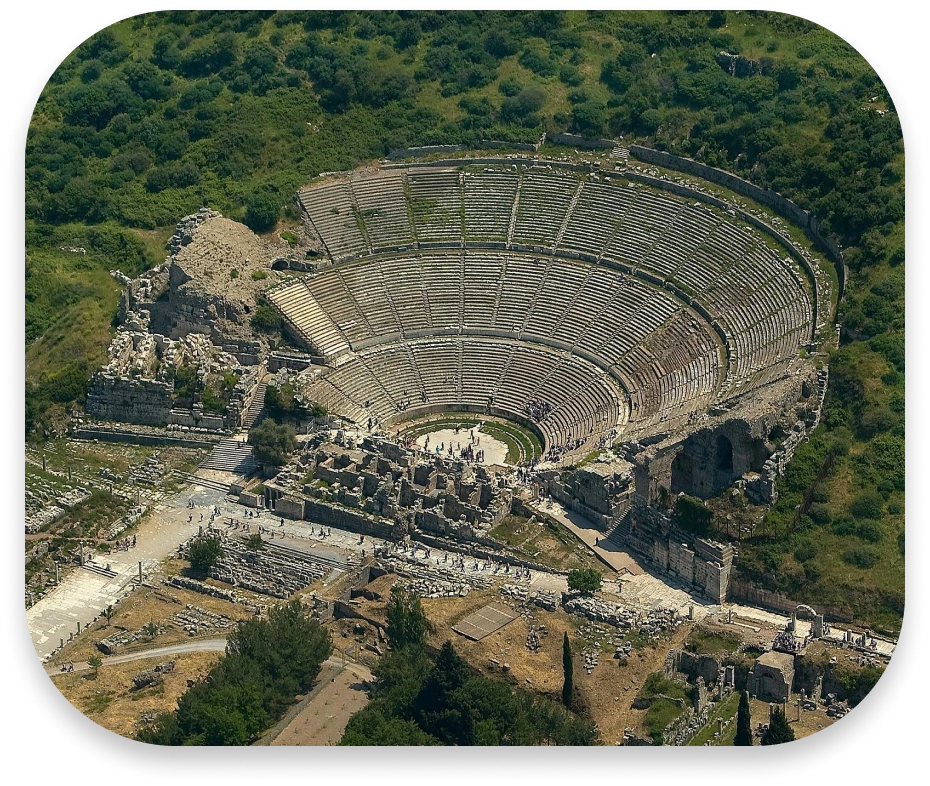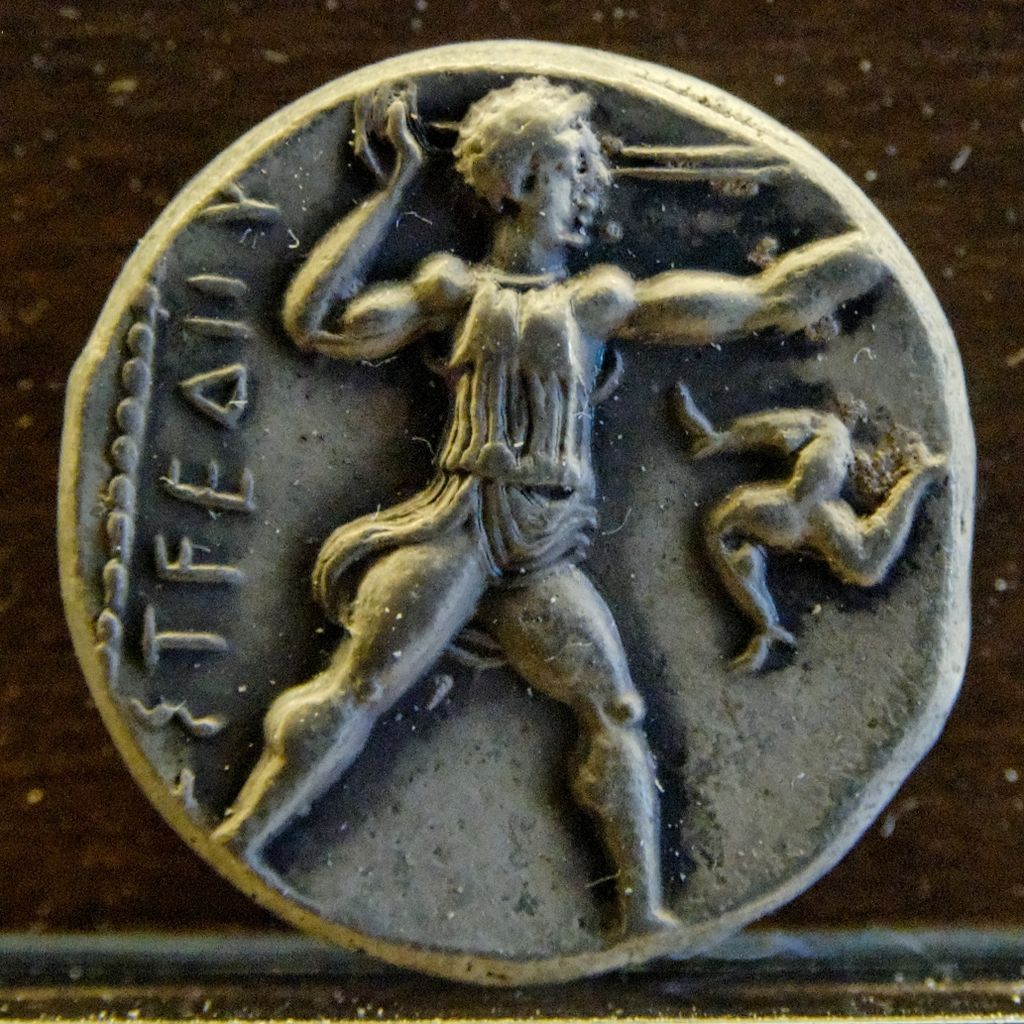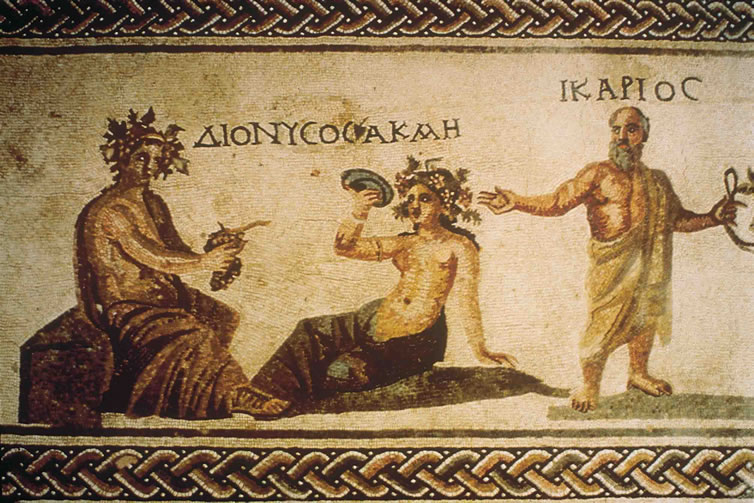Trojan (alias Ilion) Historical facts vs. “Acces”, Pseudohistorians-“Scholars” etc..
http://www.hellinon.net/NeesSelides/Trojan War.htm
All Fine Arts(:Sculpture, Architecture, Poetry, Theater), Geometry, Philosophy, Mythology, Astronomy, Mathematics, Music, Rythmic, Retoric, Pharmacology(=Medicine), Physics, Language-etymology, ,(as a clue to analyze words & improve real historical facts),Literature(=λογοτεχνία) and finally MYTHOLOGY, wich is COSMOLOGY, as well, contaning ALL the above…THAT`s HOW The Ancient HELLENIQUE(Greek) Language was CREATED: INTERRELATEDwith,(as said above): All Fine Arts(:Sculpture, Architecture, Poetry, Theater), Geometry, Philosophy, Mythology, Astronomy, Mathematics, Music, Rythmic, Retoric, Pharmacology(=Medicine), Physics, Language-etymology(it`s the Key to analyze words & improve real historical facts), Literaure(=λογοτεχνία= the art of logos= speech and word), as: HOLISTIC and COMPLETE ONE!
So when parts of History, Mythology, Language etc, are stolen, copied, ortwisted …..THEN ..Anyone with the basic intelligence, can obviously see that in faked stolen Historical facts, there`s NOT any RELATIONSHIP or CONTINUITY, What EVER are arguing by media, or pseudohistorians, “scholars” etc, due to strategical, economical, profits, inferiority complex etc! ..For example!:(The speech and clear confession of Alexander the Great(Alexandros o Megas) to both Athenians and Persians:
Firstly we intend to examine the ancient evidence on the way the Ancient Macedonians were defining themselves in reference to their own identity. Concerning their own beliefs about themselves we shall review the available evidence coming from the ancient sources, both Literary and Archaeological.
A. The Literary Evidence
The first available evidence comes from the
Macedonian king Alexander during his speech to Atheneans. Essentially we have a clear confession that Alexander considers himself a Greek.
-Had I not greatly at heart the Common welfare of Greece I should not have come to tell you; but I am myself Greek by descent, (“te gar Hellên genos eimi tôrchaion“) and I would not willingly see Greece exchange freedom for slavery. …If you prosper in this war, forget not to do something for my freedom; consider the risk I have run, out of zeal for the Greek Cause,….I am Alexander of Macedon‘
Another cited excerpt makes it even more clear that Alexander I
was proud of his Hellenic identity. While speaking to Persians:
Tell your king who sent you how a Greek man, viceroy of
the Macedonians (“anêr Hellên – Makedonôn hyparchos”)has received you hospitably
(explaining the Arithmollogical, Mathematical, Architecnical, Astronomical, Poetical, Philosophical, Mythological and Rythmical -Musical INTERCONNECTION & CONTINUITY, of the HELLENIQUE Language, as ONE HOLISTIC COMPLETE..thus The MYTHE that certain words are …Semitic or Phoenician(!!!) is NOT valid because there`s not – what so ever – any conection or ANY CONTINUITY Between the above, as a whole at all!…

The Great Necropolis of Ancient Portus – Necropoli di Porto, Comune di Fiumicino, Lazio, Italy
The floor mosaic outside Tomb 43 is likely a reference to the trade of the dead man, presumably a ship-owner, but the Greek words (“This is a place free of fear”) could give another, more metaphysical meaning to it. In that case the lighthouse of Portus would represent the reaching of peace at the end of life, a sort of “Rest in Peace”
A great number of the inscriptions on the tombs suggest Graeco-Oriental origin. Scholars believe this is because Portus and Ostica were a cosmopolitan towns where the bourgeois population was full of businessmen of non-Italian birth. Latin, however, was the language that most townspeople used during the time that the necropolis was built. Nonetheless, the presence of Graeco-Oriental inscriptions, along with Isola Sacra tombs that resembled Hellenistic tombs of Petra, suggests Roman naturalization of foreign influence, which was prominent in the Empire

The theater of Ephesus

The theatre is cut into the west slope of Mount Pion upon which the Acropolis was located. Hellenistic theatres are generally built on a natural slope of a hill in order to benefit from the gradient of the hill. The best example is the Acropolis Theatre of Pergamum which was constructed in the 3rd century BC, almost at the same time with the Ephesus Theatre. The excavations of the Great Theatre reveal that it was first constructed about 250 B.C, during the reign of Lysimachos. During the Roman period, it was enlarged and formed its current style that is seen today.
Ephesus was laid upon a grid system such as any other Hellenistic ancient city. According to this layout, major public buildings are located along the principal streets. One of the major streets of Ephesus, Arcadian runs between where the Harbor and the Great Theatre.

The temple of Artemis was in Ephesus of today’s Turkey. Called Artemision and was built in 440 BC Considered one of the Seven Wonders of the ancient world. Noteworthy is the fact that it took 120 years to be completed and was originally started by the king of Lydia, Kroisos. Pausanias says that the cult of Artemis of Ephesus was founded by natives of Asia Minor. Today the remnants not resemble anything in the magnificent temple there.The Temple was built of Pentelian marble(fromthe mountain of the best marble quality in Attica county, where Athens is lying) and limestone materials carried by ship over from neighboring Penteli. Somewhere 120 marble columns supporting the main part of the church. Each column had a height of 20 meters. Huge boulders were transported there with pulleys and connected with metal pins. After the completion of the roof decorated artists building with wonderful carved scenes. In the middle of the temple was a marble statue of Artemis. The temple was one of the greatest of the classical world, much larger than the Parthenon in Athens was built later. The base of the foundation had length 131 meters and width 79 meters.
The only restored columns that exists today. But still more glorious ruins of the city, a theater, a library, baths and many other public buildings.
IROSTRATOS AND ALEXANDER
Two hundred years later, in 356 BC The temple was destroyed by fire. Fire someone put the Irostratos, who wanted in this way to become famous(!).
By coincidence, the day of the destruction of the temple, Alexander the Great was born. Later, Alexander visited Ephesus and gave the order to build the temple again in the same position.
THE FINAL DESTRUCTION
The temple of Alexander survived until the 3rd AD century. With the passage of time the mud engulfed the port of Ephesus and the city ended up insignificant! The Goths then ransacked the temple and floods completed the destruction Today what remains of the temple in Ephesus are few boulders foundations and restored only one column!
The temple of Artemis (Diana in Latin), as it should have been 600 BC It had 120 columns of marble and were decorated with beautiful sculptures.
Croesus was the last king of Lydia, a region of Asia Minor. It was known for its many riches. 560 BC commanded to build a magnificent temple in Ephesus.
The enormous peristyle, which formed four great porticoes around the courtyard, consisted of 60Doric columns. In the round chamber which Heuzey named the ‘tholos’ to the east of the propylon, a dedicatory was found. The 5 rooms on the south side had mosaic floors, one of which – executed in pebbles – survives in excellent condition. You can see one the Greek key pattern surrounding the mosaic floor.Finally, the most important archaeological found that combine Greek key/meander and vergina sun/star is the Ivory Shield that was found in pieces in Philip´s tomb at Vergina archaeological site. The arduous process of restoration took several years – it is indeed a unique masterpiece of the 4th century B.C. You can see clearly these pan–Hellenic symbols in the picture at the beginning of the article.References1- Times of Remedies and Moon Phases by C. M. Boger, page 1322- Sally Hutchison Ceely-Geometric Style in Art, Wisconsin Academy oj Sciences, Arts and Leiters,Vol. 71, Part 2, 1983, page 33- .The Way of the Labyrinth by Helen Curry, pages 21-235- “Vergina Sun” or the “Rays of the Sun God” ?
“Hellenism, the historical course of 4000 years, created huge multinational empires (multinationals, but never multicultural, as stated by the great Greek Byzantinist Helen Glykatzi-Ahrweiler), vast kingdoms, had trade relations with dozens of peoples and countries, but often suffered barbarian invasions and peoples conquered wholly or partly by foreign armies and displaced parts of the eternal Greek territories.
The result of all these historical developments, during the Byzantine time some Greek populations to speak differnt other languages, as some Asia Minor (Turkish-speaking Greeks) to speak Latin, (Vlach-speaking Greeks), to speak slavic (Slav-speaking Greeks) to speak Albanic(arvanitofonoi Greeks), or italian (the Grekanoi of Magna Grecia in southern Italy).
The Persians referred to the Macedonians as “Yaunã Takabara” (“Greeks with hats that look like shields”).
Therefore, the fact that some segments of the population of Macedonia had formerly the sole language of a body slavogenes idiom, not a capable and sufficient criterion for the attempted in the past and attempted today by foreign centers placing them outside the Greek nation …
“As Alexander comes from Alex and the man, so the Akesandros name comes from akesis * akesios (therapy, therapeutic -Due thanks god Apollo , who also was called Akesios, as well becahe use cure diseases) and the man. What follows from this? Quite simply, that the usurpation of Alexander the Great and Philip and the name of Macedonia since our amiable neighbors leads to the conclusion that the paranoia of “Macedonism” and nationalist of lirimaton not so need an Alexander, but a Akesandrou, to submit in the treatment of learning history. These are not, from Greek side, with all the friendliness emanating from the etymological origin of an ancient Filiona …
* From the verb akeomai() = treat comes the well-known and in the language of legal medical term “anikestos” (failure) that is incurable
https://en.wikipedia.org/wiki/Argead_dynasty
|
|
|
Languages |
|
|---|---|
Ancient Macedonian,then Attic Greek, and later Koine Greek |
|
Religion |
|
Greek Polytheism |
ALEXANDER THE GREAT – ”Medallion” East of the Empire, Beroia (provincial capital of Macedonia, the Heart of Greece), 3rd century A.D., Gold, Diam. 54 mm; 96.3 g
Museu Calouste Gulbenkian, Lisboa
The obverse shows the diademed head of Alexander the Great (r. 336-323 BC). This posthumous and idealized portrait includes symbols of Alexander’s deification, one of which is the ram’s horn, characteristic of the Egyptian god Amon. This iconography derives from the type of coin introduced by one of Alexander’s immediate successors, King Lysimachos of Thrace (297-281 BC).
The reverse shows a hunting scene, with the hunter’s spear piercing a wild boar that is being attacked by two dogs. The legend “King Alexander”, which appears to the left and above, identifies the hunter.
The “medallion” is part of a treasure including twenty similar pieces found in Aboukir, Egypt, in 1902. The designation “medallion” is purely a matter of convention based on the piece’s morphology and size, as the use given to such pieces cannot be definitively established.
Ancient Dion (Genetivus of Zeus 3th declination) was a centre of the worship of Zeus and the most important spiritual sanctuary of the Ancient Macedonians.
What symbolizes the Vergina Sun?
The Vergina Sun (otherwise “Star of Vergina”) is a symbol widely used by the ancient Greeks. Although the Sun of Vergina is a symbol of Pan, became famous because of the Macedonians, who use it as a symbol of the dynasty Argead the Kingdom of Macedonia.
The typical Vergina Sun, consists of 16 rays. We can also see him with 12 or even eight rays of the sun. The sun with sixteen rays represents the following: The four rays represent the four elements of nature, LAND – SEA – FIRE – AIR and the remaining 12 rays represent the 12 gods of Olympus.
The Vergina Sun, the property represents something virgin. This is why we usually see is the ancient Greek symbol, the virgin goddess Athena. But in several other cases, it can Identify and Apollo
The Vergina Sun was a common symbol of ancient Greece and is found in coins, pottery, murals and statues, long before the Macedonian kingdom and the dynasty slow.
Dekaexasteroi and Ochtasteroi Suns presented in Macedonian and Hellenistic coins and shields Period. There is also number of Athens illustration Soldiers carry a sixteen identical symbol on their armor, from the 6th century, as well as coins from the island to the mainland Greece, as in Corfu, 5th finding century, Locris, 4th BC century.
After the union of the Greeks under the leadership of Alexander the Great, the Vergina Sun was the main symbol of Greek ethnogennesis.
The symbol of the Sun of Vergina was one of the symbols of ancient Greece, long before the rise of the Greek kingdom of Macedonia. Dozens of coins, etc. pots bearing the symbol found in many parts of Greece, outside of Macedonia.
http://ancient-medieval-macedonian-history.blogspot.com/2008/12/vergina-sun-or-rays-of-sun-god.
Vergina Sun, a Pan-Hellenic Symbol [http://ancient-medieval-macedonian-history.blogspot.com/2008/07/vergina-suna-pan-hellenic-symbol.html]7- Macedonia,
http://ancient-medieval-macedonian-history.blogspot.com/info@macedonian.com.auAustralian Macedonian Advisory Council
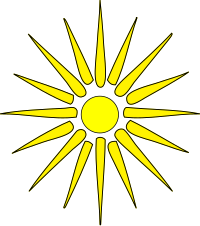
The Vergina Sun – OLD PANHELLENIC Symbol – has been proposed as a symbol of ancient Macedonia or of the Argead dynasty by archeologists.
ALEXANDER the GREAT letter to the Persian King Darious:
“Your ancestors, having campaigned in Macedonia and the rest of Greece, they hurt us while they had wronged me previously; because became leader of the Greeks and because I want to punish the Persians I spent in Asia, because you made the beginning (injustice) . Because you helped them Perinthians who unjustly wronged my father, and in Thrace, who we dominated the Ochus sent power.
And when my father was murdered by the conspirators, that you set up,as you boasted, that you killed Arsi with the help of Vagoou and seized power, nor equitable nor according to Persian law but beeing unfair to your own Persians and sending in my guilt to the other Greeks hostile letters to fight me, and sending money to the Spartans and some other Greeks who were from other cities sometimes not accepted while the Spartans took them, and when your envoys corrupted my friends, and the peace that succeeded the Greeks attempted to disperse, campaigned against you, because you have done the principle of hatred.
And I defeated in battle your first generals and your princes and now you and your powers and possess my country given to me by the gods, those of them who helped you and not been killed in battle, but fled to me, all these I am taking care of and they are with me not unwittingly but aware and conciously will join my campaing against you.
And because I’m dominating the whole of Asia, come near me. And if you are afraid lest, after you come, you suffer something bad from me, send some of their friends to get sworn assurances. Once you come to me, ask and get your mother and wife and children and everything else you want.
For what would persuade me, you shall have. And from now on, when you address me, can you address regarding equal, but if you need something, do not you address me as dominant all thy “otherwise I will think about you as wrong. But if you have a different view of the kingdom, Stay and Fight for her and do not go, because I will come against you, wherever you are. “
(Arrian, Alexander Annavasis, 2-14,)
The first settlements of Ephesus were made by the Ionians in the 11th century BC, when Androcles (from Athens), established a coastal town which was located 1.5 kilometers away from Artemis’s Temple. According to legend, he had been advised to establish a city at the place which would be shown to him by a fish and a boar. During Androcles’s reign, Ephesus became a member of the Ionian League and his descendants ruled the city for a long period. As years passed, Ephesus grew to a prosperous city and it was turned to a trade and banking centre thus ruled by rich merchants. This attracted the interest of the king of Lydia, Kroisos, with whom Ephesus had already commercial relations. Lydians conquered Ephesus and made the habitants to the inland close to the Temple of Artemis. The Lydians ruled Ephesus until the Persian Wars when the Persians took it over. However, Alexander the Great set the city free in 334 BC and after his death it was ruled by Lysimachus, a descendant of Alexander the Great.
http://ancient-medieval-macedonian-history
http://ancient-medieval-macedonian-history.blogspot.se/2008/07/vergina-suna-pan-hellenic-symbol.html
http://ancient-medieval-macedonian-history.blogspot.se/2008/12/vergina-sun-or-rays-of-sun-god.html
http://macedonia-evidence.org/obama-letter.html
Artemis
Artemis was mainly known as the goddess of hunting. She was born by Leto and Zeus. Apollowas her twin brother. According to the myth, Zeus had desired to lay with his cousin Leto. After their coupling, Leto was pregnant but Hera, the jealous wife of Zeus, had punished her by prohibiting any place of the earth, seen by the sun, accepting her giving birth to her child.
After long wanderings, Leto resorted to her sister Asteria, who had become a floating rock in order to avoind Zeus’s pursuing. Asteria, anchored in the bottom of the sea and accepted her sister who initially gave birth to Artemis and the goddess helped her mother to give birth to Apollo too. Once born, Artemis was said to be the embodiment of the moon and Apollo the embodiment of the sun.
Artemis is also known as the mood goddess as well and it was said that the silver belonged to her and that Artemis owned a silver chariot which she used to ride at night shooting arrows of silver light.
Artemis had decided to stay unmarried and preferred to live in the forests accompanied by young girls called dryads. Known as the Lady of the Wild, the wild animals were sacred to her and she punished the people who killed more than that they could eat.
Contrary to the Athenian Artemis who was a virgin, Artemis of Ephesus was considered to be the Great Mother and a sculpture depicts her with many breast signifying that she was the mother of the life.
The Romans used to name the goddess Diana instead of Artemis.
The Ionians named that goddess “Artemis” and when the Lydian king Croesus invaded the city, the temple, which was surrounded by walls and a wooden statue devoted to Artemis had been placed in it, was destroyed by a flood. Croesus started constructing the new stone temple at the same position and adorned it with columns, in the 7th century BC.
Artemis Temple (also known – many centuries later – ,as the Temple of Diana) was included among the Seven Wonders of the World. It was 115 m long and 55 m wide. Its construction lasted 120 years and its architectural order was Ionic Dipteros with double column-rows on each long and triple column-rows along the wide sides. The Temple of Artemis consisted of 127 columns with a diameter of 1.20 m and 19 m tall.
Temple of Artemis
(Recostraction)
As the city was located by the river Kaystros (nowadays known as Kucuk Menderes river) which cut off the outlet to the sea with alluvial sand, it created a marshy earth which in turn created an unhealthy environment for the population of Ephesus. Lysimachus decided to transfer the city to the valley situated between the mountains Koressos and Pion (nowadays known as Bulbul andPayir). He also fortified the city with a wall 9 km long. He named the new city after his wife,Arsinoe. The city grew again in a rich trade centre and several public buildings such as stadiums, gymnasiums, theatres etc were erected in it.
After Lysimachus’s death, the city was ruled by the Egyptians and the Syrians and it was conquered by the Romans in 190 BC. Ephesus was ruled by the Romans indirectly, throughPergamum and started blooming during the Augustan Empire era. It became the capital of the Asian province of the Roman Empire and it grew to the most important trading centre of Minor Asia, inhabited by 250,000 people. Most of the monuments, that have survived nowadays, date pack to the prosperous period.
The Goths invaded the city in 263 Ad and they destroyed both the city and the temple of Artemis. Ephesus declined since then and even though it was rebuilt, it never regained its old splendor.
During the Byzantine era, Ephesus was a very important city (5th-6th centuries AD). A big part of the city was rebuilt by Constantine I. In 614 AD the city was destroyed again due to an earthquake. Continuously, the harbor of the city turned to a marshy are once preventing the inhabitants from accessing the sea and carry on their trading activities. The harbor decline and the Arabic invasions made the population to move towards a hill where they would be protected. As they had no more a connection with the sea, the city declined and it was turned to a small village, occupied by the Turks in 1390.
Finally, the city was abandoned during the 15th century as there was no possibility to regain its past flourishing.
Hellenic scripts of what is remaining now from Ilion or Troja now days..
Danaoi and Achaoi (named the troups of both Doric, Ionic, Aiolic,& Achaic in dialect kingdoms – Troja and Ephesos Ionic dialect, Pergamos & Alicarnassos: Doric), who made the campaing against Troja – meaning war between Greeks..The Athenians (in Attica county,- Ionic Dialect), Spartans, Mychenians(Agamemnon), Achileus ,- the leader of Myrmidons & the Idol of Alexander the Great, 900 years later, Ajax(Aias) – king of Salamis, son of Isione, sister of Priamos of Troja – against his own uncle(!!). This war was not of course for the beautiful Helenas eyes sake..as always the Greek Mythology (and the Hellenic religion, as well does are based on HISTORIC facts & thus creating an ultimate pedagogical & philosophical-poetical era) dramatises in epical manners all these facts….if since some thousand years later has been grotesquely copied, and named…as …the “Old Testament”…….
The cult of Apollo emblem is phoenix in Troy. The
Troy (or Ilion), is the city-theater of the Trojan war, part of which is described in Homer’s Iliad. An ancient epic, the 9th or 8th BC century. (Iliad means “epic of Ilion”).
The beginning of the story of the Trojans mixes with myths and legends. According to Greek mythology, the Trojans were ancient people of the city of Troy in the region of Troas, in the country of Phrygia, in the land of Asia Minor. Troy was known for its riches, which won by the port trade with east and west, the beautiful clothes, iron production, and massive defensive walls. The royal family of Troy goes back to Electra and Zeus, parents of Dardanus. Electra nursed the Dardanus in the palace on the island of Samothrace. The king named the Trojans he eats people and the country Troas, from his name. The Ilos founded the city of Ilion attaching to his name. Zeus gave LiCl the Palladium. Poseidon and Apollo built the walls and fortifications around Troy for Laomedon, son of the younger group. When Laomedon refused to pay, Poseidon flooded the country and demanded the sacrifice of Isioni a sea monster. Eneskypse horse and sea monster snatched the people of the plain.
A generation before the Trojan War, Heracles captured Troy and killed Laomedon and his sons, except for young Priam. Priam later became king. During his reign, the Mycenaean Greeks invaded and captured Troy during the Trojan War. Both Trojan and the Mycenaean civilization destroyed. The Trojans Aeneas, Brutus, and Elymos escaped destruction and were founders Alva Long (neighboring city of Rome), Britain, and Elymos, a country of Sicily. The Maxyanoi was a tribe in western Libya claimed to be descendants of the Trojans, according to Herodotus. The Trojan ships metaforfothikan to Naiades, who rejoices to see the shipwreck of Odysseus.
The Iliad and The TROIKOS CYCLE
The Homer (Iliad) is one of the Homeric epics and preserved until nowadays. The composition, which according to tradition was made by Homer, placed in the 8th century BC and based on tradition oral composition and recitation of heroic poems that had developed in previous centuries. The poem, which describes some events of the tenth and final year of the siege of Troy (Ilion) by the Achaeans, written in hexameter and has 15.692 verses. Some time after creation, during the Hellenistic period, was divided into 24 rhapsodies (capital) and small changes came in this form nowadays. Each of the rhapsodies indicated by a capital letter of the Greek alphabet, while the rhapsodies of the Odyssey with a small.
The Homeric epics with the Orphic is the oldest surviving texts of ancient Greek literature in ancient Greece was considered the most important works, and used in education. As the main theme of rhapsodists, their recitation was a key part of Greek religious festivals.
The events of the Trojan War which tells the Iliad happening in tenth year of the war and unfolding in about 51 days. Top of the poem is the wrath, the wrath of Achilles, after a dispute with Agamemnon for the distribution of the spoils of the battles, leading to the withdrawal of Achilles by warfare. In the Iliad include events following the departure of Achilles and the successes of the Trojans, the entrance of Patroclus in the war with the armor of Achilles, the death of Patroclus, the return of Achilles in the battle for revenge, the death of Hector and the desecration Achillea.Telos from the tradition of the dead the Trojans Hector for burial. The episodes that have preceded ten years of war and the history of war, included in the Cypria, and the events after the burial of Hector until the fall of Troy contained in subsequent projects the Trojan cycle, Negress, Little Iliad, Ilion persita.
Case and Structure of the Iliad
The disagreement Achilles and Agamemnon and the rage of Achilles
On the first day of action, the Trojan Chrysis, priest of Apollo and father of Cressida, captive of Agamemnon, came to the camp of the Achaeans and called for the release of his daughter. But Agamemnon was adamant and challenging brutally priest, who prayed to Apollo to avenge this unacceptable behavior (hubris). Apollo responded and punished with ruinous plague the Achaean army. After nine days of illness, convened meeting of the army requested by the seer Calchas to reveal the cause of the anger of the gods. Agamemnon initially refuses to return the girl, intense wrangling with Achilles and finally persuaded to return as long to get to return one of the spoils of Achilles, the Briseis. Achilles is forced to retreat, but offended refuses to continue to fight and begs his mother, Thetis, to ask Zeus to enhance the Trojans in battle to punish the Achaeans. The meeting of Thetis with Gods delaying her son’s desire for twelve days, because Jupiter is absent in the country the Ethiopians.
The evolution of the competitions until the first embassy to Achilles
In the second rhapsody, Zeus sends a dream to Agamemnon to stimulate attack of the Trojans, misleading information that the gods support Achaeans. Agamemnon calls a meeting after disagreements Achaeans prepared for battle. When the Trojans informed and they start the preparations. Such events inserted the list of opponents forces and Greek ships. The two armies decide to judge the outcome of the battle in a duel between Paris and Menelaus. Menelaus prevail, but Aphrodite rescues Paris. Opponents decide a truce, but the gods to Assembly decide to cause the violation by the Trojans to continue the war. The battles begin, stands out the presence of Diomedes injuring even the god Mars, the two sides have significant losses, but the Trojans are in a difficult position. Hector temporarily leave the battle to ask the Troades make supplication to Athena. When he returns, he duels with Ajax(Priamos of Troja was his uncle, Hisione was the syster of Priamos), but there is no winner. Hostilities stopped because it gets dark (that day covered the rhapsodies B through H) and decided truce for burying the dead, while the Achaeans strengthen the walling of the camp. In rhapsody I described another day battles, in which the Trojans prevail, and the next two the night following the battle in which the Achaeans asking unsuccessfully Achilles to return to war.
The onslaught of the Trojans
The Rhapsody Av begins with new battles. Although initially distinguished Agamemnon and repels the Trojans to their walls, the gods encourage Hector and since then injured many heads of Greeks (Agamemnon, Diomedes, the doctor Machaonas), the Trojans go, pushing the Achaeans in retreat and pull down the walls of their camp (rhapsodies L and M). On rhapsodies N-II continues the battle around the ships of the Achaeans, who are in dire straits. Then Patroclus persuaded Achilles to give him his arms and let him lead the army of Myrmidons to deceive the Trojans and curb their enthusiasm.
Excellence and death of Patroclus
The rhapsody II continues with the entrance of Patroclus into battle. Despite the advice of Achilles confine itself to remove the Trojans from the camp and do not hunt up the city, Patroclus fights and chases up the walls, where only the intervention of Apollo was able to repulse the attack of the Achaians. During conflicts Patroclus, on the enthusiasm approached several of the city walls, followed duel with Hector, who killed him with the help of Apollo. In Rhapsody P is the battle for the body of Patroclus, in which Menelaus distinguished. Eventually Ajax manages to dislodge the dead from the Trojans, but Hector holds his armor. Wearing the armor of Achilles, Hector tries again to get the body of Patroclus, without success. In Rhapsody S. Achilles mourns the death of his friend and decides to avenge him. Thetis asks Hephaestus to build new weapons and Rhapsody ends with the extensive description of the shield made.
The return of Achilles
In Rhapsody T Achilles receives new weapons and calls a meeting of the Achaeans. Reconciles with Agamemnon, since both admit they were driven to conflict by divine intervention, and returned Briseis, whom Agamemnon swears that he had touched. After the assembly Achilles mourns Patroclus departs for battle. In Rhapsody Y conflicts begin, involving and gods. Achilles duel with Aeneas, saved by Poseidon. Achilles fought with the river god Scamander and chased the Trojans to their walls (rhapsody F). The Trojans fled the city, except for Hector, who remained on the battlefield to confront Achilles (rhapsody X). Athena misled the promised help, but ultimately supported Achilles manages to kill him. Achilles refuses to hand over the Trojans Hector. Instead, they tie him to his chariot and drags. The Rhapsody ends with the lamentations of the family of Hector.

The tradition of Hector and burial
In the days after the death of Hector Achaeans completed the funeral rites for Patroclus, burned his body and organized competitions in honor of (rhapsody Y). The last rhapsody starts with twelve days desecration of the corpse of Hector by Achilles. The twelfth day the gods make meeting and send Thetis to persuade Achilles to deliver the dead and Iris motivate Priam begging Achilles. The evening the meeting of Priam to Achilles, who accept the ransom and return the dead and decided truce for the ceremony of burning. Here are ten days laments and preparations and eleventh day is burning and burial of Hector, in which the project ends.
http://www.hellinon.net/MacedonianEvidence.htm
The first step to destroy a nation is to delete the memory.
…….Destroy his books, its culture, twisting its history…….after you put someone to write new books, manufacture a new culture, invent a new story …it will not need much time to start this nation forgetting what is and what was. The world around him will forget even faster.
Milan Kundera (The book of laughter and forgetting)
MOST POPULAR
Swastika just in Sanskrit means “That is well and is”. This symbol is Greek origin in ancient times referred to as “Double meander” or “Gammadion”. Not as swastika. Now theories k.Chitler for suns etc. I can not say because I need at least 1,000 pages to analyze. Used by Hittler when he visited a tribe of the Himalayas that had as its symbol the double meander and adopted as of them took in his words the same “Dreadful and strong knowledge.” Note that this tribe, although Buddhists consider today as spiritual fathers Greeks in particular Apollo (!)
Parts of the Phillip ivory shield that found in Vergina Tomb. You can see clearly the two Pan-Hellenic symbols: The 16th Sun/Star (Vergina Sun) and the Meander (Greek key). The shield itself can be found in the museum of Vergina in Central Macedonia, Greece. Greek Sun/Star or Vergina Sun/StarThere are many other symbols which use the rayed star (the ancient Greek symbol) across the centuries. The ancient Greek stars can contain 3-rays up to 24-rays, and all rays have many shapes, according to their inner meaning found in archaeological monuments. Many ancient archaeological findings exist today, such as ancient Greek coins, texts, icons, emblems, tituli, ostraca, fragments, epigrammata, papyrorum, tablettes, recensios, sculpures, vases, monuments etc. which make use of the ancient Greek rayed star symbol. 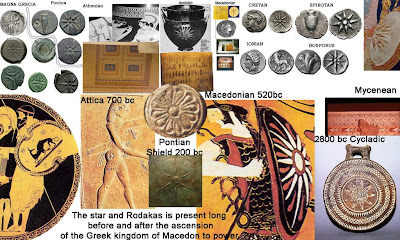
VERGINA THE ULTIMATE PANHELLENIC SYMBOL OF THE SUN (APOLLO)
Even Achilles (Alexander`s the Great Idol) has the rayed star on his armory – as well as many of the ancient Greek gods and goddesses.
Achilles was (900 years later) the idol of Alexander the Greatand Ajax (who was nephew of Priamos! Asioni – Ajax mother was Priamos sister).
HERE: playing dice, 6th cent, BC amphora The symbol is the continuation of the oldest ancient Greek(Panhellenic) symbol of the Sun, which also predominated on the Acropolis of Athens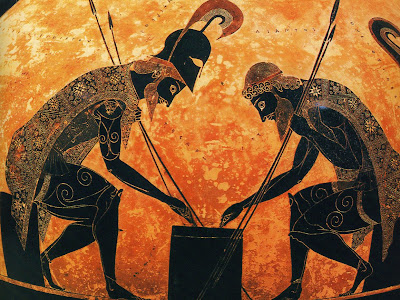
Acropolis ceiling
. 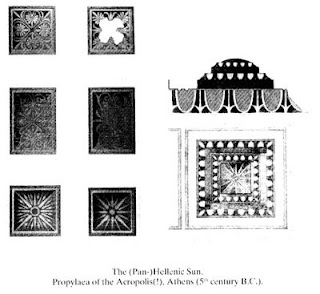
Inside the outer wall of columns of the Parthenon in Nashville, Tennessee. This «Parthenon» is a full-scale replica of the original Parthenon in Athens. It was built in 1897 as part of the Tennessee Centennial Exposition.The Sun was also the most important symbol of the origin and continuation of all Hellenes: Arcadians, Athenians, Thessalians, Macedonians – their first God, before the Olympian Gods. The choice of this symbol was obvious and natural: one of the most vital elements on earth is the Sun – the source of life.Many people call it “the Sun of Vergina” or the “Macedonian Star” but this is only a partial truth. This symbol has a history of more than three thousand years. It was the original logo or sign which the Proto-Hellenes used as their emblem for many centuries. The Macedonians simply continued the ancient Proto-Hellenic (Homeric) heritage or tradition of their forefathers. From the late 17th century AD, and in particular the 18th century, classical Greek civilization began to attract the ever-growing interest, curiosity and imagination of western Europeans. One manifestation of this was the numerous “journeys of discovery” undertaken by various scholars to the soil of “rediscovered Hellas” itself, which was then still part of the Ottoman Empire. Two such individuals were the young architects James Stuart and Nicholas Revett, who in 1751 arrived in Attica and immediately set about accurately recording the architectural details of surviving buildings of classical Athens and its surroundings. The most known Rayed Star is the ancient Greek Macedonian symbol of Vergina. The “Vergina Sun”, “Star of Vergina” or “Argead Star” is the name given to a symbol of a stylised star or sun with sixteen rays. It was unearthed in 1977 during archaeological excavations in Vergina, in the northern Greek province of Macedonia. 

The vergina star was found in the tombs of the kings of the ancient kingdom of Macedon, and was described as the symbol variously as a “star”, a “starburst” or as a “sunburst”. The well known larnax on which it appears belonged to Greek King Philip II of Macedon, the father of the Greek Alexander the Great III. The larnax is on display at the archaeological museum in Vergina. Another version of the Vergina Sun, with 12 rays, was found on the larnax of Olympias, the mother of Alexander the Great. Only the Greeks can really understand the inner, esoteric, hidden ancient meaning of the vergina symbol and, in this movie a hint of it is presented. The Macedonian Tomb of Lyson and Kallikles at Leucadia. The tomb is dated to ca. 200 B.C. The tomb was accidentally discovered in 1942 at Leucadia Emathias and subsequently excavated by Ch. Macaronas. The results of the investigation were published in a book by his collaborator, Stella Miller, in 1993.
Depictions of Macedonian shields prove that their surface was decorated in relief. This is the case, for example, with the shields carved on the balustrade of the Alhena temple al Pergamon, where the central convex part of the shield was covered with concentric circles with patterns and an eight-ray star in the middle. One of two shields shown on the walls of the tomb of Lyson and Collides is decorated with a sixteen- raystar and similar shields occur on the walls of the Agios Athanasios tumulus (Thessaloniki) excavated in 1994 .
There is a surviving fragmentary Macedonian shield with a twelve-ray star in the centre and elements of an arch-shaped ornament and eight-ray stars around the edge ; a similarly designed silver circular applique with an eight-ray star in the middle and seven arch-shaped elements around the edge was found in tomb A at Derveni. Meander or Greek Key A Greek key pattern or meander, symbolizing the flow of a river, often is found in stylized form as a border decoration on rugs, ceramics, and walls. A meander is similar to the Chinese sign for “returning,” thus it is also a symbol of rebirth and eternity.

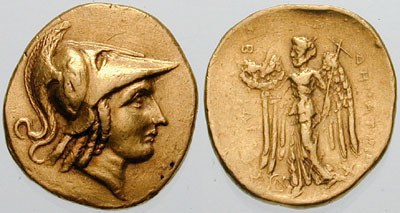
The speech and clear confession of Alexander the Great(Alexandros o Megas) to both Athenians and Persians
Firstly we intend to examine the ancient evidence on the way the Ancient Macedonians were defining themselves in reference to their own identity. Concerning their own beliefs about themselves we shall review the available evidence coming from the ancient sources, both Literary and Archaeological.
A. The Literary Evidence
The first available evidence comes from the
Macedonian king Alexander during his speech to Atheneans. Essentially we have a clear confession that Alexander considers himself a Greek.
-Had I not greatly at heart the Common welfare of Greece I should not have come to tell you; but I am myself Greek by descent, (“te gar Hellên genos eimi tôrchaion“) and I would not willingly see Greece exchange freedom for slavery. …If you prosper in this war, forget not to do something for my freedom; consider the risk I have run, out of zeal for the Greek Cause,….I am Alexander of Macedon‘1
Another cited excerpt makes it even more clear that Alexander I
was proud of his Hellenic identity. While speaking to Persians:
Tell your king who sent you how a Greek man, viceroy of
the Macedonians (“anêr Hellên – Makedonôn hyparchos”)has received you hospitably… “
This plundered cist tomb, built of limestone and situated at the edge of the Great Tumulus next to the “Ηρώον”-‘heroon'(=”Heroes Garden”, was named Tomb of Persephone because of its painted ornamentation. Prominent among figures of the Fates (Μοιραι) and of Demeter(Δήμητρα) seated on the “mirthless rock” is a depiction of the abduction of Persephone by the god of the underworld, Pluto.
The artistry of execution, strength of conception and restraint of colouring all denote an artist of great talent (perhaps Nikomachos = Battle winner from: Niki+Machi..ex: Andromache of Troja – one of the Doughters of Priamos) of the mid-4th century BC; this dating is supported by the sherds of pottery found in the interior of the tomb.
Hades abducting Persephone, a mural from the Macedonian royal tomb at Vergina, mid 4th century BC

DOUBLE CROSS MAIANDROS- AGKYLOTOS -SVASTIKA
The swastika is an extremely powerful symbol. It can be widely known by the Nazis, who used it as a symbol of the period that massacred thousands of people, but centuries ago had a positive significance. So what is the history of this symbol? Nowadays represents good or bad?
The swastika is an ancient symbol that was used for over 3000 years. . Builders such as pottery and coins from ancient Troy (Ionian Greek civilization), show that the swastika was a common symbol in use way back in 1000 BC.
Gammadion
Ancient Greek symbol of the Sun, the Gammadion or Tetraskelion, Holy Tetraktys, rightly or Sovastika, swastika.
The continuity of the Greek race, the spread of the Greek race just as the rays of the Light.
Ilios- Moon -Sellas – Greece. It is mystical Sacred symbol, ( kalos ionos-Καλός οιωνός)=good omen, (Eulogia-Ευλογία)=Blessing, (Eudemonia-Ευδαιμονία)=Bliss, (Μακροζωία-Macrozoia)=Longevity, (Gonimotita-Γονιμότητα)=Fertility, ,(Zoe & Hygeia-Ζωή και Υγεία)=Life and Health. .
Just as the Life-Giver sun supplies the earth.
It connects the past with the present and the future. The entire Greek worldview, the theogony, knowledge, birth, evolution, to infinity and the universal.
The lack and excess, the connection opposites, and yet the same forces, en-exist in Nature.
About 900 B.C. a geometric rectilinear decorative style of triangles, chequers, and meanders began to dominate. These elements were organized in rows of separate bands, encircling the vase. During this period in geometric Greece, the meander became the dominating motif on the vases. From its origin in the Palaeolithic onward, the meander (a rectilinear geometric design) was symbolic of water, perhaps because of its resemblance to waves, lightening, and rivers. The meander was adapted, or perhaps reinvented, and made more complex by the vase painters of Athens. Rectilinear decorations of meanders, triangles, and rectangles, soon covered the vase, like a mesh or mosaic design becoming one with the vase itself. The shape of the vase was influenced by the design and became more sculptural and architectonic.Archaeologists have found what we have come to call the Greek key pattern on artifacts whose dates preceded ancient Greece by thousands of years. Anthropologist Marija Gimbutas found a meander pattern on a figurine in the Ukraine that dates from 18,000 to 15,000 BCE. Many believe the root of the labyrinth pattern derives from the shifting, twisting path of the Meander River of Phrygia in the Mediterranean region of present-day Turkey.One of the most important finds made during the Vergina excavations is the splendid Hellenistic Palace, which dates from the last 3rd of the 4th c. or the beginning of the 3rd c. BC.
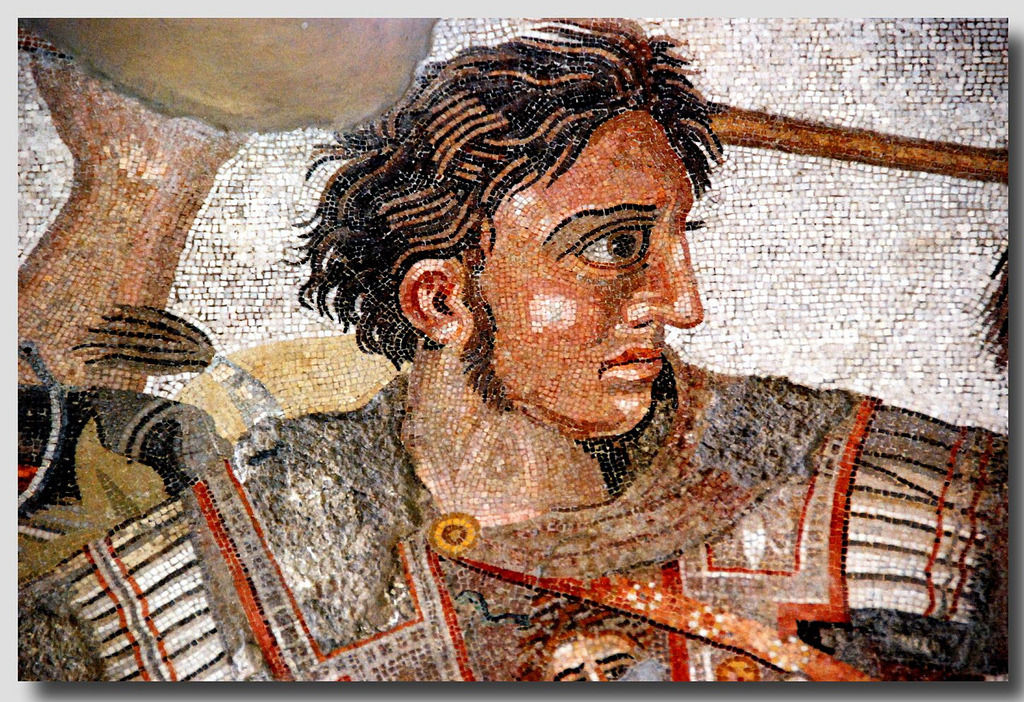
.jpg)

TITLE: Mosaic of Calliope(One of the Nine Muses; see: above:surrounded by Socrates and the seven wise men LOCATION: The National Museum of Beirut DESCRIPTION: From Baalbek, Lebanon, 3rd c. A.D. Calliope is in the middle and above

Greek Art / Greek Mosaics and Murals
These two murals shown are perfect example of the usual design of a usual mosaic and an intricate design of an unusual mosaic. The mosaic of Alexander the …https://www.google.se/search?q=alexander+the+great+mosaic&biw
Letter to President Barack Obama
ancient-scholars@macedonia-evidence.org
http://macedonia-evidence.org/obama-letter-fyrom.html
May 18, 2009
The Honorable Barack Obama
President, United States of America
White House
1600 Pennsylvania Avenue, NW
Washington, DC 20500
Dear President Obama,
We, the undersigned scholars of Graeco-Roman antiquity, respectfully request that you intervene to clean up some of the historical debris left in southeast Europe by the previous U.S. administration.
On November 4, 2004, two days after the re-election of President George W. Bush, his administration unilaterally recognized the “Republic of Macedonia.” This action not only abrogated geographic and historic fact, but it also has unleashed a dangerous epidemic of historical revisionism, of which the most obvious symptom is the misappropriation by the government in Skopje of the most famous of Macedonians, Alexander the Great.
We believe that this silliness has gone too far, and that the U.S.A. has no business in supporting the subversion of history. Let us review facts. (The documentation for these facts [here in boldface] can be found attached and at: http://macedonia-evidence.org/documentation.html)
The land in question, with its modern capital at Skopje, was called Paionia in antiquity. Mts. Barnous and Orbelos (which form today the northern limits of Greece) provide a natural barrier that separated, and separates, Macedonia from its northern neighbor. The only real connection is along the Axios/Vardar River and even this valley “does not form a line of communication because it is divided by gorges.”
While it is true that the Paionians were subdued by Philip II, father of Alexander, in 358 B.C. they were not Macedonians and did not live in Macedonia. Likewise, for example, the Egyptians, who were subdued by Alexander, may have been ruled by Macedonians, including the famous Cleopatra, but they were never Macedonians themselves, and Egypt was never called Macedonia.
Rather, Macedonia and Macedonian Greeks have been located for at least 2,500 years just where the modern Greek province of Macedonia is. Exactly this same relationship is true for Attica and Athenian Greeks, Argos and Argive Greeks, Corinth and Corinthian Greeks, etc.
We do not understand how the modern inhabitants of ancient Paionia, who speak Slavic – a language introduced into the Balkans about a millennium after the death of Alexander – can claim him as their national hero. Alexander the Great was thoroughly and indisputably Greek. His great-great-great grandfather, Alexander I, competed in the Olympic Games where participation was limited to Greeks.
Even before Alexander I, the Macedonians traced their ancestry to Argos, and many of their kings used the head of Herakles – the quintessential Greek hero – on their coins.
Euripides – who died and was buried in Macedonia– wrote his play Archelaos in honor of the great-uncle of Alexander, and in Greek. While in Macedonia, Euripides also wrote the Bacchai, again in Greek. Presumably the Macedonian audience could understand what he wrote and what they heard.
Alexander’s father, Philip, won several equestrian victories at Olympia and Delphi, the two most Hellenic of all the sanctuaries in ancient Greece where non-Greeks were not allowed to compete. Even more significantly, Philip was appointed to conduct the Pythian Games at Delphi in 346 B.C. In other words, Alexander the Great’s father and his ancestors were thoroughly Greek. Greek was the language used by Demosthenes and his delegation from Athens when they paid visits to Philip, also in 346 B.C.
Another northern Greek, Aristotle, went off to study for nearly 20 years in the Academy of Plato. Aristotle subsequently returned to Macedonia and became the tutor of Alexander III. They used Greek in their classroom which can still be seen near Naoussa in Macedonia.
Alexander carried with him throughout his conquests Aristotle’s edition of Homer’s Iliad. Alexander also spread Greek language and culture throughout his empire, founding cities and establishing centers of learning. Hence inscriptions concerning such typical Greek institutions as the gymnasium are found as far away as Afghanistan. They are all written in Greek.
The questions follow: Why was Greek the lingua franca all over Alexander’s empire if he was a “Macedonian”? Why was the New Testament, for example, written in Greek?
The answers are clear: Alexander the Great was Greek, not Slavic, and Slavs and their language were nowhere near Alexander or his homeland until 1000 years later. This brings us back to the geographic area known in antiquity as Paionia. Why would the people who live there now call themselves Macedonians and their land Macedonia? Why would they abduct a completely Greek figure and make him their national hero?
The ancient Paionians may or may not have been Greek, but they certainly became Greekish, and they were never Slavs. They were also not Macedonians. Ancient Paionia was a part of the Macedonian Empire. So were Ionia and Syria and Palestine and Egypt and Mesopotamia and Babylonia and Bactria and many more. They may thus have become “Macedonian” temporarily, but none was ever “Macedonia”. The theft of Philip and Alexander by a land that was never Macedonia cannot be justified.
The traditions of ancient Paionia could be adopted by the current residents of that geographical area with considerable justification. But the extension of the geographic term “Macedonia” to cover southern Yugoslavia cannot. Even in the late 19th century, this misuse implied unhealthyterritorial aspirations.
The same motivation is to be seen in school maps that show the pseudo-greater Macedonia, stretching from Skopje to Mt. Olympus and labeled in Slavic. The same map and its claims are in calendars, bumper stickers, bank notes, etc., that have been circulating in the new state ever since it declared its independence from Yugoslavia in 1991. Why would a poor land-locked new state attempt such historical nonsense? Why would it brazenly mock and provoke its neighbor?
However one might like to characterize such behavior, it is clearly not a force for historical accuracy, nor for stability in the Balkans. It is sad that the United States of America has abetted and encouraged such behavior.
We call upon you, Mr. President, to help – in whatever ways you deem appropriate – the government in Skopje to understand that it cannot build a national identity at the expense of historic truth. Our common international society cannot survive when history is ignored, much less when history is fabricated.
Sincerely,
NAME |
TITLE |
INSTITUTION |
Anagnostis P. Agelarakis, Professor of Anthropology, Adelphi University (USA)
Ioannis M. Akamatis, Professor of Classical Archaeology, University of Thessaloniki (Greece)
June W. Allison, Professor Emerita, Department of Greek and Latin, The Ohio State University (USA)
Georgios Anagnostopoulos, Professor of Philosophy, University of California-San Diego (USA)
Mariana Anagnostopoulos, Assistant Professor of Philosophy, California State University, Fresno (USA)
Ronnie Ancona, Professor of Classics, Hunter College and The Graduate Center, CUNY (USA)
John P. Anton, Distinguished Professor of Greek Philosophy and Culture University of South Florida (USA)
Dr. Norman George Ashton, Senior Honorary Research Fellow, The University of Western Australia (Australia)
Lucia Athanassaki, Associate Professor of Classical Philology, University of Crete (Greece)
Effie F. Athanassopoulos, Associate Professor Anthropology and Classics, University of Nebraska-Lincoln (USA)
Harry C. Avery, Professor of Classics, University of Pittsburgh (USA)
Dr. Dirk Backendorf. Akademie der Wissenschaften und der Literatur Mainz (Germany)
Elizabeth C. Banks, Associate Professor of Classics (ret.), University of Kansas (USA)
Leonidas Bargeliotes, Emeritus Professor of Philosophy, University of Athens, President of the Olympic Center for Philosophy and Culture (Greece)
Alice Bencivenni, Ricercatore di Storia Greca, Università di Bologna (Italy)
David L. Berkey, Assistant Professor of History, California State University, Fresno (USA)
Luigi Beschi, professore emerito di Archeologia Classica, Università di Firenze (Italy)
Josine H. Blok, professor of Ancient History and Classical Civilization, Utrecht University (The Netherlands)
Alan Boegehold, Emeritus Professor of Classics, Brown University (USA)
Efrosyni Boutsikas, Lecturer of Classical Archaeology, University of Kent (UK)
Ewen Bowie, Emeritus Fellow, Corpus Christi College, Oxford (UK)
Keith Bradley, Eli J. and Helen Shaheen Professor of Classics, Concurrent Professor of History, University of Notre Dame (USA)
Kostas Buraselis, Professor of Ancient History, University of Athens (Greece)
Stanley M. Burstein, Professor Emeritus, California State University, Los Angeles (USA)
Francis Cairns, Professor of Classical Languages, The Florida State University (USA)
John McK. Camp II, Agora Excavations and Professor of Archaeology, ASCSA, Athens (Greece)
David A. Campbell, Emeritus Professor of Classics. University of Victoria, B.C. (Canada)
Paul Cartledge, A.G. Leventis Professor of Greek Culture, University of Cambridge (UK)
Paavo Castren, Professor of Classical Philology Emeritus, University of Helsinki (Finland)
William Cavanagh, Professor of Aegean Prehistory, University of Nottingham (UK)
Angelos Chaniotis, Professor, Senior Research Fellow, All Souls College, Oxford (UK)
Paul Christesen, Professor of Ancient Greek History, Dartmouth College (USA)
James J. Clauss, Professor of Classics, University of Washington (USA)
Ada Cohen, Associate Professor of Art History, Dartmouth College (USA)
Randall M. Colaizzi, Lecturer in Classical Studies, University of Massachusetts-Boston (USA)
Kathleen M. Coleman, Professor of Latin, Harvard University (USA)
Rev. Dr. Demetrios J Constantelos, Charles Cooper Townsend Professor of Ancient and Byzantine history, Emeritus; Distinguished Research Scholar in Residence at the Richard Stockton College of New Jersey (USA)
Michael B. Cosmopoulos, Ph.D., Professor and Endowed Chair in Greek Archaeology, University of Missouri-St. Louis (USA)
Carole L. Crumley, PhD., Professor of European Archaeology, University of North Carolina, Chapel Hill (USA)
Kevin F. Daly, Assistant Professor of Classics, Bucknell University (USA)
Joseph W. Day, Professor of Classics, Wabash College (USA)
François de Callataÿ, Professor of Monetary and financial history of the Greek world, Ecole Pratique des Hautes Etudes (Paris/Sorbonne) and Professor of Financial history of the Greco-Roman world, Université libre de Bruxelles (France and Brussels)
Wolfgang Decker, Professor emeritus of sport history, Deutsche Sporthochschule, Köln (Germany)
Luc Deitz, Außerplanmäßger Professor of Mediaeval and Renaissance Latin, University of Trier (Germany), and Curator of manuscripts and rare books, National Library of Luxembourg (Luxembourg)
Charalambos Dendrinos, Lecturer in Byzantine Literature and Greek Palaeography, Acting Director, The Hellenic Institute, Royal Holloway, University of London (UK)
Michael Dewar, Professor of Classics, University of Toronto (Canada)
John D. Dillery, Associate Professor of Classics, University of Virginia (USA
John Dillon, Emeritus Professor of Greek, Trinity College Dublin (Ireland)
Sheila Dillon, Associate Professor, Depts. of Art, Art History & Visual Studies and Classical Studies, Duke University (USA)
Michael D. Dixon, Associate Professor of History, University of Southern Indiana (USA)
Douglas Domingo-Foraste, Professor of Classics, California State University, Long Beach (USA)
Myrto Dragona-Monachou, Professor emerita of Philosophy, University of Athens (Greece)
Stella Drougou, Professor of Classical Archaeology, Aristotle University of Thessaloniki (Greece)
Pierre Ducrey, professeur honoraire, Université de Lausanne (Switzerland)
John Duffy, Professor, Department of the Classics, Harvard University (USA)
Roger Dunkle, Professor of Classics Emeritus, Brooklyn College, City University of New York (USA)
Michael M. Eisman, Associate Professor Ancient History and Classical Archaeology, Department of History, Temple University (USA)
Mostafa El-Abbadi, Professor Emeritus, University of Alexandria (Egypt)
R. Malcolm Errington, Professor für Alte Geschichte (Emeritus) Philipps-Universität, Marburg (Germany)
Christos C. Evangeliou, Professor of Ancient Hellenic Philosophy, Towson University, Maryland, Honorary President of International Association for Greek Philosophy (USA)
Panagiotis Faklaris, Assistant Professor of Classical Archaeology, Aristotle University of Thessaloniki (Greece)
Denis Feeney, Giger Professor of Latin, Princeton University (USA)
Michael Ferejohn, Associate Professor of Ancient Philosophy, Duke University (USA)
Kleopatra Ferla, Ph.D. in Ancient History, Head of Research and Management of Cultural Information, Foundation of the Hellenic World, Athens (Greece)
Elizabeth A. Fisher, Professor of Classics and Art History, Randolph-Macon College (USA)
Nick Fisher, Professor of Ancient History, Cardiff University (UK)
R. Leon Fitts, Asbury J Clarke Professor of Classical Studies, Emeritus, FSA, Scot., Dickinson Colllege (USA)
John M. Fossey FRSC, FSA, Emeritus Professor of Art History (and Archaeology), McGill Univertsity, Montreal, and Curator of Archaeology, Montreal Museum of Fine Arts (Canada)
Dr. Athanasios Fotiou, Adjunct Professor, College of the Humanities, Greek and Roman Studies, Carleton University, Ottawa (Canada)
Robin Lane Fox, University Reader in Ancient History, New College, Oxford (UK)
Dr. Lee Fratantuono, William Francis Whitlock Professor of Latin, Ohio Wesleyan University (USA)
Stavros Frangoulidis, Associate Professor of Latin. Aristotelian University of Thessaloniki (Greece)
William K. Freiert, Professor of Classics and Hanson-Peterson Chair of Liberal Studies, Gustavus Adolphus College (USA)
Rainer Friedrich, Professor of Classics Emeritus, Dalhousie University, Halifax, N.S. (Canada)
Heide Froning, Professor of Classical Archaeology, University of Marburg (Germany)
Peter Funke, Professor of Ancient History, University of Münster (Germany)
Traianos Gagos, Professor of Greek and Papyrology, University of Michigan (USA)
Karl Galinsky, Cailloux Centennial Professor of Classics, University of Texas, Austin (USA)
Robert Garland, Roy D. and Margaret B. Wooster Professor of the Classics, Colgate University, Hamilton NY (USA)
Hans-Joachim Gehrke, Prof. Dr., President of the German Archaeological Institute Berlin (Germany)
Dr. Ioannis Georganas, Researcher, Department of History and Archaeology, Foundation of the Hellenic World (Greece)
Douglas E. Gerber, Professor Emeritus of Classical Studies, University of Western Ontario (Canada)
Dr. Andre Gerolymatos, Chair and Professor of Hellenic Studies, Simon Fraser University (Canada)
Stephen L. Glass, John A. McCarthy Professor of Classics & Classical Archaeology, Pitzer College: The Claremont Colleges (USA)
Hans R. Goette, Professor of Classical Archaeology, University of Giessen (Germany); German Archaeological Institute, Berlin (Germany)
Sander M. Goldberg, Professor of Classics, UCLA (USA)
Mark Golden, Professor, Department of Classics, University of Winnipeg (Canada)
Ellen Greene, Joseph Paxton Presidential Professor of Classics, University of Oklahoma (USA)
Robert Gregg, Teresa Moore Professor of Religious Studies, Emeritus, Director, The Abbasi Program in Islamic Studies, Stanford University (USA)
Frederick T. Griffiths, Professor of Classics, Amherst College (USA)
Dr. Peter Grossmann, Member emeritus, German Archaeological Institute, Cairo (Egypt)
Erich S. Gruen, Gladys Rehard Wood Professor of History and Classics, Emeritus, University of California, Berkeley (USA)
Martha Habash, Associate Professor of Classics, Creighton University (USA)
Christian Habicht, Professor of Ancient History, Emeritus, Institute for Advanced Study, Princeton (USA)
Donald C. Haggis, Nicholas A. Cassas Term Professor of Greek Studies, University of North Carolina at Chapel Hill (USA)
Judith P. Hallett, Professor of Classics, University of Maryland, College Park, MD (USA)
Kim Hartswick, Academic Director, CUNY Baccalaureate for Unique and Interdisciplinary Studies, New York City (USA)
Prof. Paul B. Harvey, Jr. Head, Department of Classics and Ancient Mediterranean Studies, The Pennsylvania State University (USA)
Eleni Hasaki, Associate Professor of Classical Archaeology, University of Arizona (USA)
Rosalia Hatzilambrou, Ph.D., Researcher, Academy of Athens (Greece)
Miltiades B. Hatzopoulos, Director, Research Centre for Greek and Roman Antiquity, National Research Foundation, Athens (Greece)
Stephan Heilen, Associate Professor of Classics, University of Illinois at Urbana- Champaign (USA)
Wolf-Dieter Heilmeyer, Prof. Dr., Freie Universität Berlin und Antikensammlung der Staatlichen Museen zu Berlin (Germany)
Pontus Hellstrom, Professor of Classical archaeology and ancient history, Uppsala University (Sweden)
Steven W. Hirsch, Associate Professor of Classics and History, Tufts University (USA)
Karl-J. Holkeskamp, Professor of Ancient History, University of Cologne (Germany)
Frank L. Holt, Professor of Ancient History, University of Houston (USA)
Dan Hooley, Professor of Classics, University of Missouri (USA)
Meredith C. Hoppin, Gagliardi Professor of Classical Languages, Williams College, Williamstown, MA (USA)
Caroline M. Houser, Professor of Art History Emerita, Smith College (USA) and Affiliated Professor, University of Washington (USA)
Professor Carl Huffman, Department of Classics, DePauw University (USA)
John Humphrey, Professor of Greek and Roman Studies, University of Calgary (Canada)
Frosen Jaakko, Professor of Greek philology, University of Helsinki (Finland)
Dr Thomas Johansen, Reader in Ancient Philosophy, University of Oxford (UK)
Vincent Jolivet, Archaeologist CNRS, Paris [French School Rome] (Italy)
Georgia Kafka, Visiting Professor of Modern Greek Language, Literature and History, University of New Brunswick (Canada)
Mika Kajava, Professor of Greek Language and Literature; Head of the Department of Classical Studies, University of Helsinki (Finland)
Anthony Kaldellis, Professor of Greek and Latin, The Ohio State University (USA)
Eleni Kalokairinou, Assistant Professor of Philosophy, Secretary of the Olympic Center of Philosophy and Culture (Cyprus)
Lilian Karali, Professor of Prehistoric and Environmental Archaeology, University of Athens (Greece)
Andromache Karanika, Assistant Professor of Classics, University of California, Irvine (USA)
Robert A. Kaster, Professor of Classics and Kennedy Foundation Professor of Latin, Princeton University (USA)
Dr. Athena Kavoulaki, Lecturer, Department of Philology, University of Crete, Rethymnon (Greece)
Vassiliki Kekela, Adjunct Professor of Greek Studies, Classics Department, Hunter College, City University of New York (USA)
John F. Kenfield, Associate Professor, Department of Art History, Rutgers University (USA)
Dietmar Kienast, Professor Emeritus of Ancient History, University of Düsseldorf (Germany)
Karl Kilinski II, University Distinguished Teaching Professor, Southern Methodist University (USA)
Dr. Florian Knauss, associate director, Staatliche Antikensammlungen und Glyptothek München (Germany)
Denis Knoepfler, Professor of Greek Epigraphy and History, Collège de France (Paris, France)
Ortwin Knorr, Associate Professor of Classics, Willamette University (USA)
Robert B. Koehl, Professor of Archaeology, Department of Classical and Oriental Studies Hunter College, City University of New York (USA)
Thomas Koentges, Visiting lecturer, Ancient History, University of Leipzig (Germany)
Georgia Kokkorou-Alevras, Professor of Classical Archaeology, University of Athens (Greece)
Ann Olga Koloski-Ostrow, Associate Professor and Chair, Department of Classical Studies, Brandeis University (USA)
Eric J. Kondratieff, Assistant Professor of Classics and Ancient History, Department of Greek & Roman Classics, Temple University (USA)
Dr Eleni Kornarou, Visiting Lecturer of Ancient Greek Literature, Dept. of Classic and Philosophy, University of Cyprus (Cyprus)
Haritini Kotsidu, Apl. Prof. Dr. für Klassische Archäologie, Goethe-Universität, Frankfurt/M. (Germany)
Lambrini Koutoussaki, Dr., Lecturer of Classical Archaeology, University of Zürich (Switzerland)
David Kovacs, Hugh H. Obear Professor of Classics, University of Virginia (USA)
Prof. Dr. Ulla Kreilinger, Institut für Klassische Archäologie, Universität Erlangen (Germany)
Dr. Christos Kremmydas, Lecturer in Ancient Greek History, Royal Holloway, University of London (UK)
Peter Krentz, W. R. Grey Professor of Classics and History, Davidson College (USA)
Friedrich Krinzinger, Professor of Classical Archaeology Emeritus, University of Vienna (Austria)
Michael Kumpf, Professor of Classics, Valparaiso University (USA)
Donald G. Kyle, Professor of History, University of Texas at Arlington (USA)
Prof. Dr. Dr. h.c. Helmut Kyrieleis, former president of the German Archaeological Institute, Berlin (Germany)
Margaret L. Laird, Assistant Professor, Roman art and archaeology, University of Washington (USA)
Gerald V. Lalonde, Benedict Professor of Classics, Grinnell College (USA)
Steven Lattimore, Professor Emeritus of Classics, University of California, Los Angeles (USA)
Francis M. Lazarus, President, University of Dallas (USA)
Mary R. Lefkowitz, Andrew W. Mellon Professor in the Humanities, Emerita Wellesley College (USA)
Irene S. Lemos FSA, Professor in Classical Archaeology,, S.Ioannou Centre for Classical and Byzantine Studies, Oxford University (UK)
Ioannes G. Leontiades, Assistant Professor of Byzantine History, Aristotle University of Thessaloniki (Greece)
Iphigeneia Leventi, Assistant Professor of Classical Archaeology, University of Thessaly (Greece)
Daniel B. Levine, Professor of Classical Studies, University of Arkansas (USA)
Christina Leypold, Dr. phil., Archaeological Institute, University of Zürich (Switzerland)
Vayos Liapis, Associate Professor of Greek, Centre d’Etudes Classiques & Departement de Philosophie, Université de Montreal (Canada)
Hugh Lloyd-Jones, Professor of Greek Emeritus, University of Oxford (UK)
Yannis Lolos, Assistant Professor, History, Archaeology, and Anthropology, University of Thessaly (Greece)
Stanley Lombardo, Professor of Classics, University of Kansas (USA)
Anthony Long, Professor of Classics and Irving G. Stone Professor of Literature, University of California, Berkeley (USA)
Julia Lougovaya, Assistant Professor, Department of Classics, Columbia University (USA)
Dr. John Ma, Lecturer in Ancient History, Oxford University and Tutorial Fellow in Ancient History, Corpus Christi College, Oxford (UK)
A.D. Macro, Hobart Professor of Classical Languages emeritus, Trinity College (USA)
John Magee, Professor, Department of Classics, Director, Centre for Medieval Studies, University of Toronto (Canada)
Dr. Christofilis Maggidis, Associate Professor of Archaeology, Dickinson College (USA)
Chryssa Maltezou, Professor emeritus, University of Athens, Director of the Hellenic Institute of Byzantine and Postbyzantine Studies in Venice (Italy)
Jeannette Marchand, Assistant Professor of Classics, Wright State University, Dayton, Ohio (USA)
Evangeline Markou, Adjunct Lecturer in Greek History, Open University of Cyprus (Cyprus)
Anna Marmodoro, Faculty of Philosophy, University of Oxford (UK)
Richard P. Martin, Antony and Isabelle Raubitschek Professor in Classics, Stanford University (USA)
Maria Mavroudi, Professor of Byzantine History, University of California, Berkeley (USA)
Jody Maxmin, Associate Professor, Dept. of Art & Art History, Stanford University (USA)
Alexander Mazarakis-Ainian, Professor of Classical Archaeology, University of Thessaly (Greece)
James R. McCredie, Sherman Fairchild Professor emeritus; Director, Excavations in Samothrace Institute of Fine Arts, New York University (USA)
Brian McGing M.A., Ph.D., F.T.C.D., M.R.I.A., Regius Professor of Greek, Trinity College Dublin (Ireland)
James C. McKeown, Professor of Classics, University of Wisconsin-Madison (USA)
Richard McKirahan, Edwin Clarence Norton of Classics and Professor of Philosophy, Pitzer College: The Claremont Colleges (USA)
Robert A. Mechikoff, Professor and Life Member of the International Society of Olympic Historians, San Diego State University (USA)
Andreas Mehl, Professor of Ancient History, Universität Halle-Wittenberg (Germany)
John Richard Melville-Jones, Winthrop Professor, Classics and Ancient History, University of Western Australia (Australia)
Marion Meyer, Professor of Classical Archaeology, University of Vienna (Austria)
Dr. Aristotle Michopoulos, Professor & Chair, Greek Studies Dept., Hellenic College (Brookline, MA, USA)
Harald Mielsch, Professor of Classical Archaeology, University of Bonn (Germany)
Stephen G. Miller, Professor of Classical Archaeology Emeritus, University of California, Berkeley (USA)
Lynette G. Mitchell, Senior Lecturer in Classics & Ancient History, Exeter University (UK)
Phillip Mitsis, A.S. Onassis Professor of Classics and Philosophy, New York University (USA)
Peter Franz Mittag, Professor für Alte Geschichte, Universität zu Köln (Germany)
David Gordon Mitten, James Loeb Professor of Classical Art and Archaeology, Harvard University (USA)
Mette Moltesen, MA, Curator of Ancient Art, Ny Carlsberg Glyptotek, Copenhagen (Denmark)
Margaret S. Mook, Associate Professor of Classical Studies, Iowa State University (USA)
Anatole Mori, Associate Professor of Classical Studies, University of Missouri- Columbia (USA)
William S. Morison, Associate Professor of Ancient History, Grand Valley State University (USA)
Jennifer Sheridan Moss, Associate Professor, Wayne State University (USA)
Aliki Moustaka, Professor of Classical Archaeology, Aristotelian University of Thessaloniki (Greece)
Mark Munn, Professor of Ancient Greek History and Greek Archaeology, the Pennsylvania State University (USA)
Ioannis Mylonopoulos, Assistant Professor of Greek Art History and Archaeology, Columbia University, New York (USA)
Alexander Nehamas, Edmund N. Carpenter II Class of 1943 Professor in the Humanities, Professor of Philosophy and Comparative Literature, Princeton University (USA)
Richard Neudecker, PD of Classical Archaeology, Deutsches Archäologisches Institut Rom (Italy)
James M.L. Newhard, Associate Professor of Classics, College of Charleston (USA)
Carole E. Newlands, Professor of Classics, University of Wisconsin, Madison (USA)
Andrew G. Nichols, Visiting Lecturer of Classics, University of Florida (USA)
Jessica L. Nitschke, Assistant Professor of Classics, Georgetown University (USA)
John Maxwell O’Brien, Professor of History, Queens College, City University of New York (USA)
James J. O’Hara, Paddison Professor of Latin, The University of North Carolina, Chapel Hill (USA)
Martin Ostwald, Professor of Classics (ret.), Swarthmore College and Professor of Classical Studies (ret.), University of Pennsylvania (USA)
Olga Palagia, Professor of Classical Archaeology, University of Athens (Greece)
Beata M. Kitsikis Panagopoulos, Professor of Art History, Retired, San Jose State University, Caifornia (USA)
Christos Panayides, Associate Professor of Philosophy, University of Nicosia, (Cyprus)
Vassiliki Panoussi, Associate Professor of Classical Studies, The College of William and Mary (USA)
Maria C. Pantelia, Professor of Classics, University of California, Irvine (USA)
Pantos A.Pantos, Adjunct Faculty, Department of History, Archaeology and Social Anthropology, University of Thessaly (Greece)
Eleni Papaefthymiou, Curator of the Numismatic Collection of the Foundation of the Hellenic World (Greece)
Maria Papaioannou, Assistant Professor in Classical Archaeology, University of New Brunswick (Canada)
Anthony J. Papalas, Professor of Ancient History, East Carolina University (USA)
Nassos Papalexandrou, Associate Professor, The University of Texas at Austin (USA)
Polyvia Parara, Visiting Assistant Professor of Greek Language and Civilization, Department of Classics, Georgetown University (USA)
Richard W. Parker, Associate Professor of Classics, Brock University (Canada)
Robert Parker, Wykeham Professor of Ancient History, New College, Oxford (UK)
Robert J. Penella, Professor and Chairman, Classics, Fordham University (USA)
Anastasia-Erasmia Peponi, Associate Professor of Classics, Stanford University (USA)
Jacques Perreault, Professor of Greek archaeology, Universite de Montreal, Quebec (Canada)
Patrick Pfeil, magister artium Universität Leipzig, Alte Geschichte (Germany)
Edward A. Phillips, Professor of Classics at Grinnell College (USA)
Yanis Pikoulas, Associate Professor of Ancient Greek History, University of Thessaly (Greece)
Lefteris Platon, Assistant Professor of Archaeology, University of Athens (Greece)
John Pollini, Professor of Classical Art & Archaeology, University of Southern California (USA)
David Potter, Arthur F. Thurnau Professor of Greek and Latin. The University of Michigan (USA)
Daniel Potts, Edwin Cuthbert Hall Professor of Middle Eastern Archaeology, University of Sydney (Australia)
Robert L. Pounder, Professor Emeritus of Classics, Vassar College (USA)
Nikolaos Poulopoulos, Assistant Professor in History and Chair in Modern Greek Studies, McGill University (Canada)
Selene Psoma, Senior Lecturer of Ancient History, University of Athens (Greece)
William H. Race, George L. Paddison Professor of Classics, University of North Carolina at Chapel Hill (USA)
John T. Ramsey, Professor of Classics, University of Illinois at Chicago (USA)
Christian R. Raschle, Assistant Professor of Roman History, Centre d’Etudes Classiques & Departement d’Histoire, Université de Montreal (Canada)
Karl Reber, Professor of Classical Archaeology, University of Lausanne (Switzerland)
Gary Reger, Professor of History Trinity College, Connecticut (USA)
Rush Rehm, Professor of Classics and Drama, Stanford University (USA)
Heather L. Reid, Professor of Philosophy, Morningside College (USA)
Christoph Reusser, Professor of Classical Archaeology, University of Zürich (Switzerland)
Werner Riess, Associate Professor of Classics, The University of North Carolina at Chapel Hill (USA)
Dr Tracey E Rihll, Senior lecturer, Department of Classics, Ancient History and Egyptology, Swansea University ( Wales, UK)
Robert H. Rivkin, Ancient Studies Department, University of Maryland Baltimore County (USA)
Walter M. Roberts III, Assistant Professor of Classics, University of Vermont (USA)
Barbara Saylor Rodgers, Professor of Classics, The University of Vermont (USA)
Robert H. Rodgers. Lyman-Roberts Professor of Classical Languages and Literature, University of Vermont (USA)
Guy MacLean Rogers, Kemper Professor of Classics and History, Wellesley College (USA)
Roberto Romano, professore di ruolo (II level) di Civiltà bizantina e Storia bizantina, Università “Federico II” di Napoli (Italy)
Nathan Rosenstein, Professor of Ancient History, The Ohio State University (USA)
John C. Rouman, Professor Emeritus of Classics, University of New Hampshire, (USA)
Dr. James Roy, Reader in Greek History (retired), University of Nottingham (UK)
Steven H. Rutledge, Associate Professor of Classics, Department of Classics, University of Maryland, College Park (USA)
Daniel J. Sahas, Professor Emeritus, University of Waterloo (Canada)
Christina A. Salowey, Associate Professor of Classics, Hollins University (USA)
Pierre Sanchez, Professor of Ancient History, University of Geneva (Switzerland)
Theodore Scaltsas, Professor of Ancient Greek Philosophy, University of Edinburgh (UK)
Thomas F. Scanlon, Professor of Classics, University of California, Riverside (USA)
Thomas Schäfer, Professor, Institut für Klassische Archäologie, Universität Tübingen (Germany)
Bernhard Schmaltz, Prof. Dr. Archäologisches Institut der CAU, Kiel (Germany)
Prof. Dr. Andras Schmidt-Colinet, Professor of Classical Archaeology, University of Vienna (Austria)
Robert C. Schmiel, Prof. Emeritus of Greek & Roman Studies, University of Calgary (Canada)
Rolf M. Schneider, Professor of Classical Archaeology, Ludwig-Maximilians-Universität München (Germany)
Joseph B. Scholten, PhD, Associate Director, Office of International Programs/Affiliate Assoc. Prof. of Classics, University of Maryland, College Park (USA)
Peter Scholz, Professor of Ancient History and Culture, University of Stuttgart (Germany)
Christof Schuler, director, Commission for Ancient History and Epigraphy of the German Archaeological Institute, Munich (Germany)
Paul D. Scotton, Assoociate Professor Classical Archaeology and Classics, California State University Long Beach (USA)
Danuta Shanzer, Professor of Classics and Medieval Studies, The University of Illinois at Urbana-Champaign and Fellow of the Medieval Academy of America (USA)
James P. Sickinger, Associate Professor of Classics, Florida State University (USA)
Athanasios Sideris, Ph.D., Head of the History and Archaeology Department, Foundation of the Hellenic World, Athens (Greece)
G. M. Sifakis, Professor Emeritus of Classics, Aristotle University of Thessaloniki & New York University (Greece & USA)
Christos Simelidis, British Academy Postdoctoral Fellow, Lincoln College, University of Oxford (UK)
Henk W. Singor, Associate Professor of Ancient History Leiden University (Netherlands)
Prof. Dr. Ulrich Sinn, Professor of Classical Archaeology, University of Wurzburg (Germany)
Marilyn B. Skinner Professor of Classics, University of Arizona (USA)
Niall W. Slater, Samuel Candler Dobbs Professor of Latin and Greek, Emory University (USA)
Peter M. Smith, Associate Professor of Classics, University of North Carolina at Chapel Hill (USA)
Dr. Philip J. Smith, Research Associate in Classical Studies, McGill University (Canada)
Susan Kirkpatrick Smith Assistant Professor of Anthropology Kennesaw State University (USA)
Antony Snodgrass, Professor Emeritus of Classical Archaeology, University of Cambridge (UK)
Gina M. Soter, Lecturer IV, Classical Studies, The University of Michigan (USA)
Slawomir Sprawski, Assistant Professor of Ancient History, Jagiellonian University, Krakow (Poland)
Stylianos V. Spyridakis, Professor of Ancient History. University of California, Davis (USA)
Theodosia Stefanidou-Tiveriou, Professor of Classical Archaeology, Aristotle University of Thessaloniki (Greece)
Rachel Sternberg, Associate Professor of Classics, Case Western Reserve University (USA)
Dr. Tom Stevenson, Lecturer in Classics and Ancient History, University of Queensland (Australia)
Andrew Stewart, Nicholas C. Petris Professor of Greek Studies, University of California, Berkeley (USA)
Oliver Stoll, Univ.-Prof. Dr., Alte Geschichte/ Ancient History, Universität Passau (Germany)
Richard Stoneman, Honorary Fellow, University of Exeter (UK)
Ronald Stroud, Klio Distinguished Professor of Classical Languages and Literature Emeritus, University of California, Berkeley (USA)
Sarah Culpepper Stroup, Associate Professor of Classics, University of Washington (USA)
Dr Panico J. Stylianou, Lecturer in Ancient History, Lady Margaret Hall, University of Oxford (UK)
Thomas A. Suits, Emeritus Professor of Classical Languages, University of Connecticut (USA)
Nancy Sultan, Professor and Director, Greek & Roman Studies, Illinois Wesleyan University (USA)
Peter Michael Swan, Professor of History Emeritus, University of Saskatchewan (Canada)
David W. Tandy, Professor of Classics, University of Tennessee (USA)
James Tatum, Aaron Lawrence Professor of Classics, Dartmouth College (USA)
Martha C. Taylor, Associate Professor of Classics, Loyola College in Maryland (USA)
Petros Themelis, Professor Emeritus of Classical Archaeology, Athens (Greece)
Eberhard Thomas, Priv.-Doz. Dr., Archäologisches Institut der Universität zu Köln (Germany)
Michalis Tiverios, Professor of Classical Archaeology, Aristotle University of Thessaloniki (Greece)
Michael K. Toumazou, Professor of Classics, Davidson College (USA)
Stephen V. Tracy, Professor of Greek and Latin Emeritus, Ohio State University (USA)
Prof. Dr. Erich Trapp, Austrian Academy of Sciences/Vienna resp. University of Bonn (Germany)
Christopher Trinacty, Keiter Fellow in Classics, Amherst College (USA)
Stephen M. Trzaskoma, Associate Professor of Classics, University of New Hampshire (USA)
Vasiliki Tsamakda, Professor of Christian Archaeology and Byzantine History of Art, University of Mainz (Germany)
Christopher Tuplin, Professor of Ancient History, University of Liverpool (UK)
Yannis Tzifopoulos, Associate Professor of Ancient Greek and Epigraphy, Aristotle University of Thessaloniki (Greece)
Gretchen Umholtz, Lecturer, Classics and Art History, University of Massachusetts, Boston (USA)
Panos Valavanis, Professor of Classical Archaeology, University of Athens (Greece)
Eric R. Varner, Associate Professor, Departments of Classics and Art History, Emory University, Atlanta (USA)
Athanassios Vergados, Visiting Assistant Professor of Classics, Franklin & Marshall College (USA)
Frederik J. Vervaet, PhD, Lecturer in Ancient History. School of Historical Studies The University of Melbourne (Australia)
Christina Vester, Assistant Professor of Classics, University of Waterloo (Canada)
Dr. Zsolt Visy, Leiter Universität Pécs Lehrstuhl für Alte Geschichte und Archäologie, Archäologisches Seminar (Hungary)
Emmanuel Voutiras, Professor of Classical Archaeology, Aristotle University of Thessaloniki (Greece)
Speros Vryonis, Jr., Alexander S. Onassis Professor (Emeritus) of Hellenic Civilization and Culture, New York University (USA)
Michael B. Walbank, Professor Emeritus of Greek, Latin & Ancient History, The University of Calgary (Canada)
Dr. Irma Wehgartner, Curator of the Martin von Wagner Museum der Universität Wurzburg (Germany)
Bonna D. Wescoat, Associate Professor, Art History and Ancient Mediterranean Studies, Emory University (USA)
E. Hector Williams, Professor of Classical Archaeology, University of British Columbia (Canada)
Peter James Wilson FAHA, William Ritchie Professor of Classics, The University of Sydney (Australia)
Roger J. A. Wilson, Professor of the Archaeology of the Roman Empire, and Director, Centre for the Study of Ancient Sicily, University of British Columbia, Vancouver (Canada)
Engelbert Winter, Professor for Ancient History, University of Münster (Germany)
Timothy F. Winters, Ph.D. Alumni Assn. Distinguished Professor of Classics Austin Peay State University (USA)
Ioannis Xydopoulos, Assistant Professor in Ancient History, Aristotle University of Thessaloniki (Greece)
David C. Young, Professor of Classics Emeritus, University of Florida (USA)
Maria Ypsilanti, Assistant Professor of Ancient Greek Literature, University of Cyprus (Cyprus)
Katerina Zacharia, Associate Professor and Chair, Department of Classics & Archaeology, Loyola Marymount University (USA)
Michael Zahrnt, Professor für Alte Geschichte, Universität zu Köln (Germany)
Paul Zanker, Professor Emeritus of Classical Studies, University of Munich (Germany)
Froma I. Zeitlin, Ewing Professor of Greek Language & Literature, Professor of Comparative Literature, Princeton University (USA)
332 signatures as of June 22nd, 2009, that were sent with the update.
The original letter sent on May 18th, 2009, had 200 signatures.
For the growing list of scholars, please go to the Addenda.
cc: J. Biden, Vice President, USA
H. Clinton, Secretary of State USA
P. Gordon, Asst. Secretary-designate, European and Eurasian Affairs
H.L Berman, Chair, House Committee on Foreign Affairs
I. Ros-Lehtinen, Ranking Member, House Committee on Foreign Affairs
J. Kerry, Chair, Senate Committee on Foreign Relations
R.G. Lugar, Ranking Member, Senate Committee on Foreign Relations
R. Menendez, United States Senator from New Jersey.
Addenda
3 Scholars added on June 25th 2009:
Jerker Blomqvist, Professor emeritus of Greek Language and literature, Lund University (Sweden)
Christos Karakolis, Assistant Professor of New Testament, University of Athens (Greece)
Chrys C. Caragounis, Professor emeritus of New Testament Exegesis and the development of the Greek language since ancient times, Lund University (Sweden)
5 Scholars added on June 29th 2009:
Harold D. Evjen, Professor Emeritus of Classical Studies, University of Colorado at Boulder (USA)
Hara Tzavella-Evjen, Professor Emerita of Classical Archaeology, University of Colorado at Boulder (USA)
Michael Paschalis, Professor of Classics, Department of Philology, University of Crete, Rethymnon (Greece)
Vrasidas Karalis, Professor, New Testament Studies, The University of Sydney (Australia)
Emilio Crespo, Professor of Greek Philology, Universidad Autónoma de Madrid (Spain)
2 Scholars added on July 8th 2009:
Dr. Zoi Kotitsa, Archaeologist, Scientific research fellow, University of Marburg (Germany)
Dr. Ekaterini Tsalampouni, Assistant Lecturer in New Testament, Graeco-Roman antiquity and Koine Greek, Ludwig-Maximillian University of Munich (Germany)
2 Scholars added on July 18th 2009:
Karol Myśliwiec, Professor Dr., Director of the Research Centre for Mediterranean Archaeology, Polish Academy of Sciences, Warsaw (Poland)
Stephen Neale, Distinguished Professor of Philosophy and Linguistics, John H. Kornblith Family Chair in the Philosophy of Science and Values, City University of New York (USA)
1 Scholar added on July 20th 2009:
Marsh McCall, Professor Emeritus, Department of Classics, Stanford University (USA)
1 Scholar added on August 10th 2009:
Georgia Tsouvala, Assistant Professor of History, Illinois State University (USA)
1 Scholar added on September 3rd 2009:
Mika Rissanen, PhL, Ancient History, University of Jyvaskyla (Finland)
2 Scholars added on October 10th 2009:
José Antonio Fernández Delgado. Professor of Greek Philology, Universidad de Salamanca (Spain)
Zinon Papakonstantinou, Assistant Professor of Hellenic Studies, Henry M. Jackson School of International Studies, University of Washington, Seattle (USA)
1 Scholar added on October 17th 2009:
Eugene Afonasin, Professor of Greek Philosophy and of Roman Law, Novosibirsk State University (Russia)
1 Scholar added on October 28th 2009:
Hartmut Wolff, Professor für Alte Geschichte (emeritus), Universität Passau (Germany)
1 Scholar added on October 30th 2009:
Eleni Manakidou, Assistant Professor of Classical Archaeology, Aristoteles University of Thessaloniki (Greece)
1 Scholar added on November 3rd 2009:
Pavlos Sfyroeras, Associate Professor of Classics, Middlebury College (USA)
1 Scholar added on November 11th 2009:
Konstantinos Kapparis, Associate Professor of Classics, Department of Classics, University of Florida (USA)
1 Scholar added on November 14th 2009:
Prof. Dr. Ingomar Weiler, Professor Emeritus, Ancient Greek and Roman History, Karl-Franzens-Universität of Graz (Austria)
1 Scholar added on November 15th 2009:
Werner Petermandl, Universitätslektor, Karl-Franzens-Universität of Graz (Austria)
1 Scholar added on December 4th 2009:
István Kertész, Professor of ancient Greco-Roman history, Department of Ancient and Medieval History, Pedagogic College in Eger (Hungary)
1 Scholar added on March 11th 2010:
Nassi Malagardis, chargée de Mission au Département des Antiquités Grecques, Etrusques et Romaines du Musée du Louvre, Paris (France)
2 Scholars added on March 25th 2010:
Gonda Van Steen, Professor, Department of Classics, University of Florida (USA)
Robert Wagman, Associate Professor of Classics, Department of Classics, University of Florida (USA)
2 Scholars added on March 27th 2010:
Angelos Barmpotis, Ph.D., Director of the Digital Epigraphy and Archaeology Project, University of Florida (USA)
Eleni Bozia, Ph.D. Visiting Lecturer, Department of Classics, University of Florida (USA)
1 Scholar added on April 16th 2010:
Timothy Johnson, Associate Professor, Department of Classics, University of Florida (USA)
1 Scholar added on April 17th 2010:
Christos C. Tsagalis, Associate Professor of Classics, Aristotle University of Thessaloniki (Greece)
1 Scholar added on August 31st 2010:
Potitsa Grigorakou, Lecturer in Hellenism in the Orient, Public University of Athens (Greece)
2 Scholars added on September 3rd 2010:
Maurice Sartre, Professor of Ancient History, emeritus. Université François-Rabelais, Tours (France)
Apostolos Bousdroukis, Researcher, Institute for Greek and Roman Antiquity, National Hellenic Research Foundation (Greece)
1 Scholar added on September 10th 2010:
Alastar Jackson, Hon. Research Fellow in Ancient History, Manchester University (U.K.)
1 Scholar added on October 5th 2010:
Frances Van Keuren, Professor Emerita of Ancient Art History, University of Georgia (USA)
1 Scholar added on December 4th 2010:
Thomas Heine Nielsen, Associate Professor of Ancient Greek, University of Copenhagen (Denmark)
1 Scholar added on April 18th 2011:
Antonis Bartsiokas, Associate Professor of Anthropology, Department of History and Ethnology, University of Thrace (Greece)
1 Scholar added on October 16th 2011:
Thanasis Maskaleris, Emeritus Professor of Classics and Comparative Literature, San Francisco State University (USA)
1 Scholar added on February 22nd 2013:
Stephen Bertman, Professor Emeritus of Classics, The University of Windsor (Canada)
1 Scholar added on October 12th 2013:
Helen Karabatzaki, Associate Professor emeritus of Ancient Greek Philosophy, University of Ioannina (Greece)

National Museum, Beirut, Lebanon. A Mosaic From Baalbek, Dating …
… Alexander the Great. National Museum, Beirut, Lebanon. A mosaic from Baalbek, dating from the 4th

5-67 Head of Alexander the Great, from Pella, Macedonia, ca. 200-150 B.C. Marble, approx. 1′ high. Archeological Museum, Pella.

Head in marble of Young Alexander, found on the Akropolis, Athens. ca. 338 – 330 BC. (Akropolis Museum, Athens)

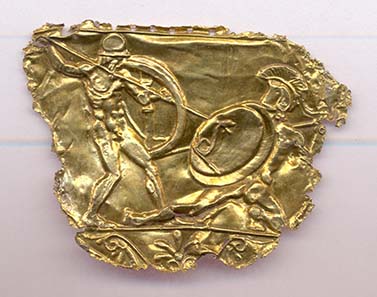
Tetradrachm minted by Alexander the Great, featuring head of Herakles (above is Heracles in Gold) on the obverse, ca. 336-326 BC

Silver tetradrachm(=Four Drachma Coin) minted by Ptolemy I Soter of Egypt. Obverse: Head of Alexander

Silver tetradrachm minted by Lysimachus of Thrace. Obverse: Alexander with horns of Ammon

Alexander “Keraunophoros”(=thundercarrier – Phoro=to srry;ie: metaphoric, Christophoros=the one, who is carring Christ etc; See. Etymology on the board)), carnelian gemstone inscribed “Of Neisos”. (Hermitage Museum, St. Petersburg)

. Silver tetradrachm minted by Philip II of Macedon. obverse: Zeus. ca. 340 BC.

Macedonian coin:
(in English: “ALEXANDER’S”) Macedonian coin, stating in Greek: “ΑΛΕΞΑΝΔΡΟΥ”
(in English: “ALEXANDER’S”)
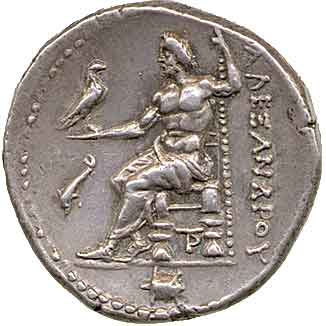
HOLY SYMBOLS OF GREEK GODS
Zeus(Zupiter later in Latin)
Symbols: Thunderbolt, Aegis, Kotinos 
Animals: Eagle, Bull, Rooster
Trees & Plants: Oak Sage. Secondary: Olive, Margaret, Amaranto, Marjoram, Walnut, Mullein, verbena, almond, violet, cassia, carnation, rope.
Neptune 
Symbols: Trident
Animals:’logo, Dolphin, Taurus
Stones: beryllium Aquamarine, Pearl
Trees & Plants: Pine, Sea Anemone, Seaweed. Secondary: linden, Outrikoularia.
Ades
| Hades with Cerberus (Heraklion Archaeological Museum) | |
| Abode | The Underworld |
|---|---|
| Symbol | Cerberus, Drinking horn, scepter, Cypress,Narcissus, key |
| Consort | Persephone |
| Parents | Cronus and Rhea |
| Siblings | Poseidon, Demeter,Hestia, Hera, Zeus, Chiron |
| Children | Macaria, Melinoe andZagreus |
| Roman equivalent | Dis Pater, Orcus |

Trees & Plants: Cypress, Rodia. Secondary: Mint, Narcissus, Corn.
Hera

Symbols: Diadem, Scepter
Animals: Peacock, Cow
Trees & Plants: Lily, Orange. Secondary: Apple, Willow, Sikia, Myrrh.
ATHENA (Latinizased to Minerva)

Symbols: Aegis
Animals: Owl, Snake
Trees & Plants: Olive. Secondary: Oak, Birch, Stafragkatho, Mulberry.
ΑΠΟΛΛΩΝ – APOLLO:
Symbols: Lyra, Bow & Arrow
Animals: Kourouna, Wolf
Stones: Sapphire
Trees & Plants: Daphne. Secondary: Sunflower, Sunflower, mistletoe (Guy), Hyacinth, Orange,’nithos, Fenugreek, Phoenix, Lily, Leek.

Artemis – (Diana)

Symbols: Bow & Arrow, Crescent
Animals: Deer, Hawk
Stones: Amethyst, Selinolithos, Pearl
Trees & Plants: Willow, Jasmine, Beech, Myrtle. Secondary: Amaranth, Margarita, Hazel, Yarrow, Balm, Acacia, Mandrake, rue.
Αφροδίτη – Aphrodite
Symbols: Dolphin, Rose, Scallop Shell, Myrtle, Dove,Sparrow, Girdle, Mirror, and Swan (Roman copy of 2nd century AD), National Archaeological Museum, Athens)

Άρης – Ares
Symbols: Spear & Sword
Animals: Dog, Orne
Stones: Onyx, Sardonyx
Trees & Plants: mint, rue, linden, verbena, Adelochorto.

Δήμητρα – Demeter (Ceres in Latin)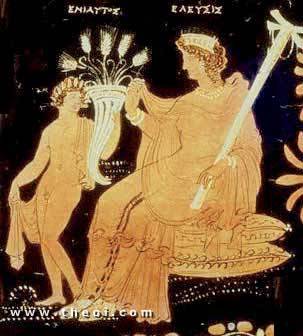
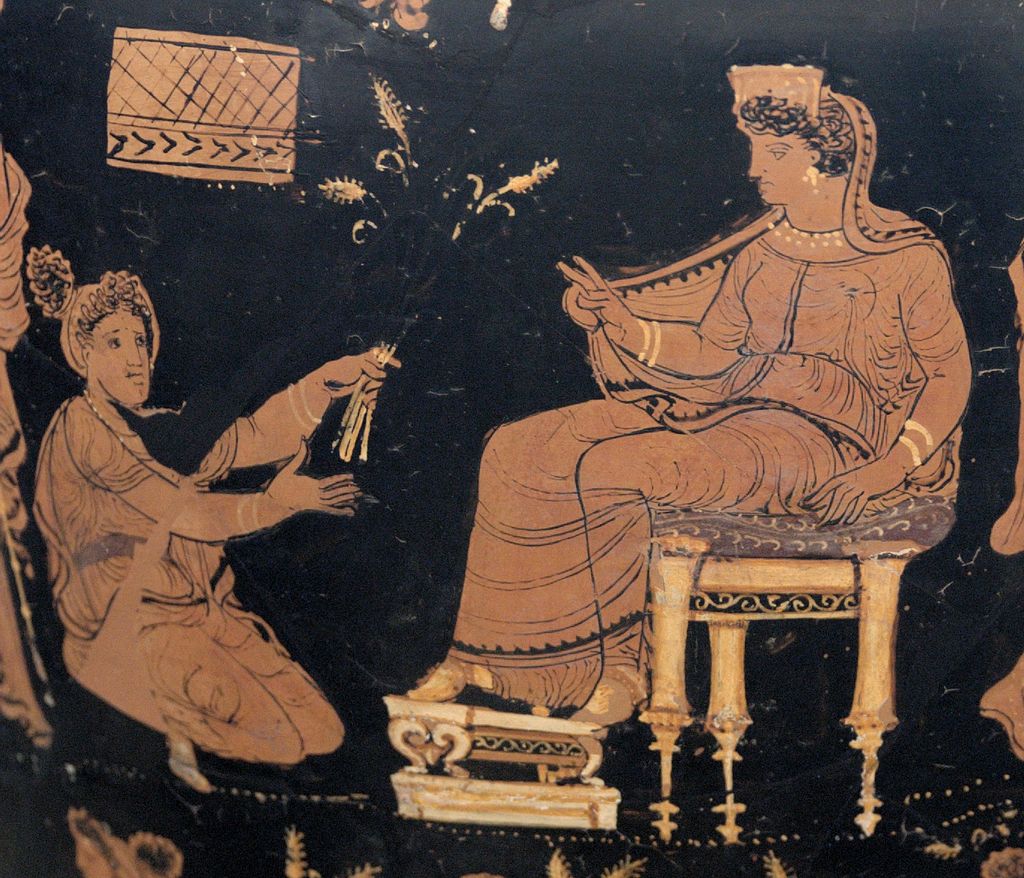
Didrachme from Paros island, struck at the Cyclades and representing Demeter
Symbols: Sickle, Torch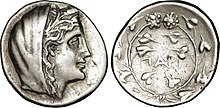
Animals: Snake
Stones: Emerald
Trees & Plants: Ear, Barley. Secondary: Willow, Corn, Rodia, haricot, Vlichouni, Poppy.
| Abode | Mount Olympus |
|---|---|
| Symbol | Cornucopia, Wheat, Torch,Bread |
| Consort | Iasion, Zeus, Oceanus,Karmanor, Poseidon andTriptolemus |
| Parents | Cronus and Rhea |
| Siblings | Hestia, Hera, Hades,Poseidon, Zeus, Chiron |
| Children | Persephone, Despoina,Arion, Plutus, Philomelus,Eubuleus, Chrysothemisand Amphitheus I |
| Roman equivalent | Ceres |
| Festivals | Thesmophoria |
Demeter. Roman copy of Greek original fom: 420 f.Kr.
Symbols: Sickle, Torch
Animals: Snake
Stones: Emerald
Trees & Plants: Ear, Barley. Secondary: Willow, Corn, Rodia, haricot, Vlichouni, Poppy.

Ερμής – Hermes
Symbols: caduceus, winged sandals
Animals: Goat
Metals: Mercury
Trees & Plants: Almond, Spruce. Secondary:’nithos, Phoenix, Hazel, Clove, Cinnamon, Mulberry.
 Hermes Hermes with his mother Maia. Detail of the side B of an Attic red-figure belly-amphora, c. 500 BC.
Hermes Hermes with his mother Maia. Detail of the side B of an Attic red-figure belly-amphora, c. 500 BC.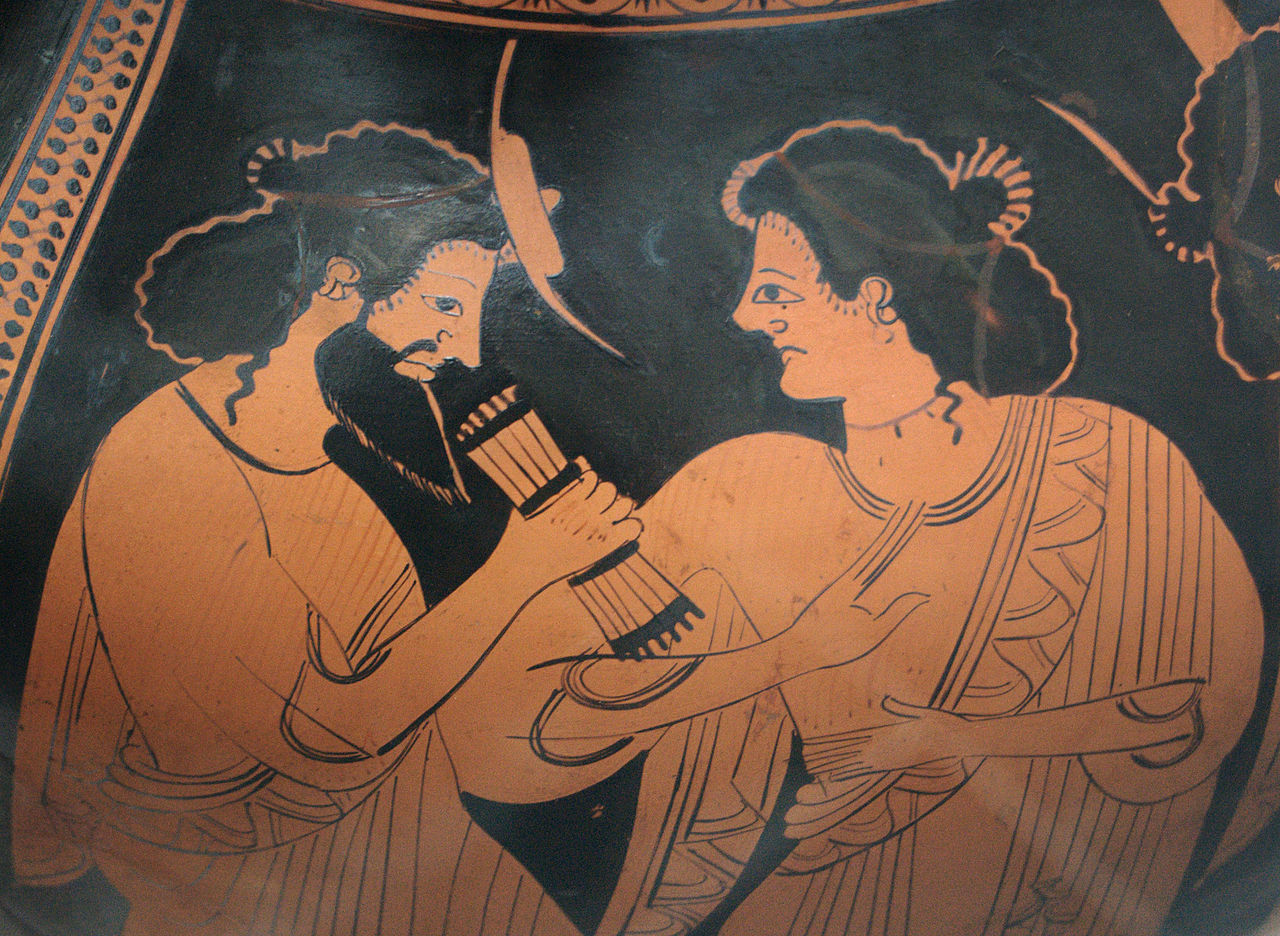
Ήφαιστος – Hephaestus
Symbols: Hammer & Anvil, ax, Fire
Trees & Plants: Margarita. Stones: Emerald, Lazouri, Pearl
Trees & Plants: Rose, Lily, Anemone, Milia, Myrtle. Secondary: Aloe, fern, heather, benzoin, myrrh, Quince, Sandalwood, Angelica, Pear, Astir, Afroxylia (elder), Violet.

Aris – (Mars)
Symbols: Spear & Sword
Animals: Dog, Orne
Stones: Onyx, Sardonyx
Trees & Plants: mint, rue, linden, verbena, Adelochorto.
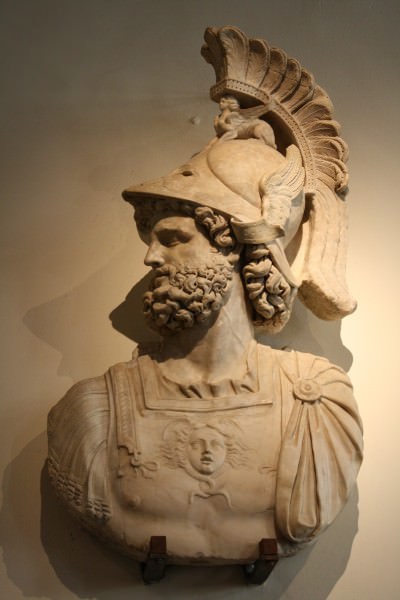
Hephaestus 
Symbols: Hammer & Anvil, ax, Fire
Trees & Plants: Margarita.
Pan 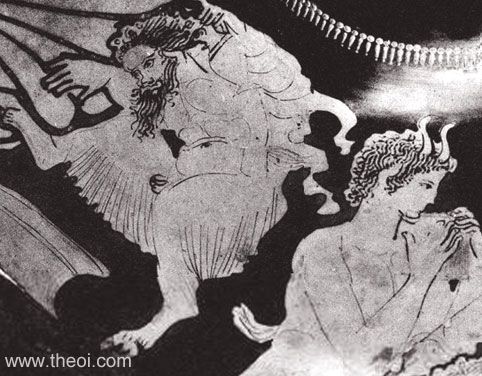
Symbols: Flute, Phallus
Animals: Goat, Ram, stag, Taurus
Trees & Plants: Pine, Spruce,’mpelos. Secondary: Vanilla, Reed, Daffodil, Orchid, chin, Silenus, Savory, Fern, Wild Flowers.
Dionysos
Symbols: Thyrsos, Phallus
Animals: Snake
Stones: Amethyst
Trees & Plants: Ivy,‘mpelos. Secondary: Aesculapius, Sikia, tinder, Fennel, Tamarix, Mushroom.
Dionysus riding the Panthers. Floor mosaic.
October 120-80 dd. to n.э. Delos House
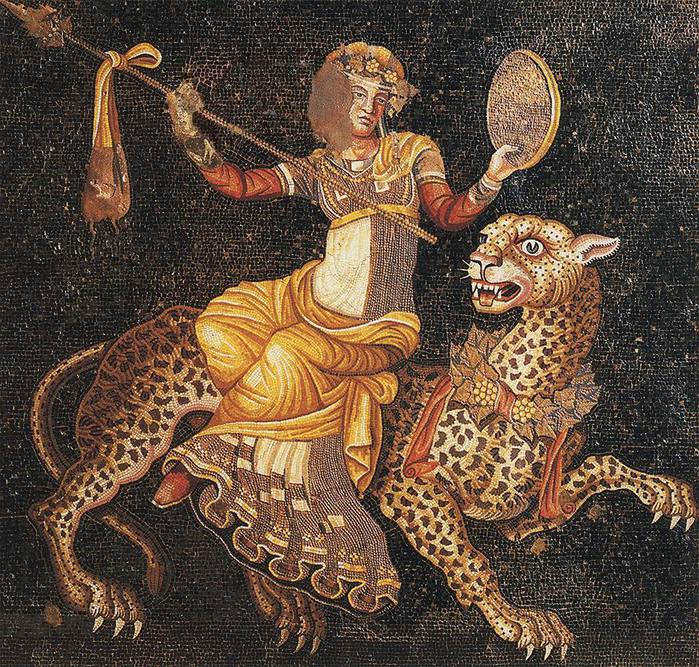
Hecate
Symbols: Manual
Animals: Snake, Dog (usually black)
Stones: Amethyst, Selinolithos, Pearl
Trees & Plants: Lavender, Myrrh, Willow. Secondary: aconite, cyclamen, Garlic, Mint, Mandrake, belladonna.
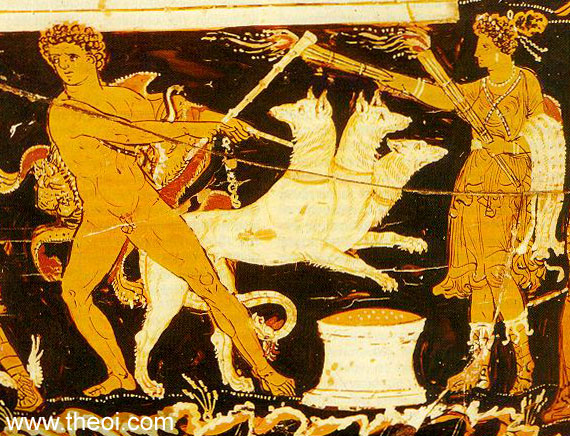
EROS – (Cupid)
Stones: Opal
Trees & Plants: Rose red, white violet, Cane.
Prometheus – (/prəˈmiːθiːəs/ prə-mee-thee-əs;Greek:Προμηθεύς [promɛːtʰeús], meaning “forethought”) is aTitan in Greek mythology, best known as the benefactor who brought fire to mankind. Prometheussided with Zeus and the ascending Olympian gods in the vast cosmological struggle against Cronus(Kronos) and the other Titans. Prometheus was therefore on the conquering side of the cataclysmic war of the Greek gods, theTitanomachy, where Zeusand the Olympian gods ultimately defeated Cronusand the other Titans.
Prometheus symbolizes the strong man who towered over the fate of the mortal, who touched the divine in man and open the road to sovereignty over the hostile environment.
The body of the fire was really ensarkotis all knowledge. Here formed the archetype of Prometheus. Prometheus is the wise who won the knowledge and pass it to humans. Culture came from the thought that the wise.
The tragedy of the hero makes the model of the tragic human or political person and in it the expression gained worldwide fame. Prometheus was a god and unlike all the other demigods were begotten. He ascended to Olympus with his strength and his mind.
Prometheus also symbolizes the ingenuity and foresight. It symbolizes the spirit of independence toward power (DIAS). Displays the strength of mind and will.
But the works of tragic poets Aeschylus and especially the myth gets another dimension. For Aeschylus in his work “Prometheus Bound” Prometheus gave gifts – knowledge – people to help them avoid extinction (30-34, 108-109). Faded from mortal fear of death (261-262) gave fire to mankind (264), arts (266) and gave them the mind and thought, origin of culture and all the arts (architecture, Arithmetic, Georgia, Navigation, Medical, Divination, Metallurgy etc).
Aeschylus in his work expresses the ideal of the citizen, who alone decided and acted, he knew to be erected in front of the fate and beats with its rationale. And this logic he wants to express in the theater. Prometheus will become a symbol of the tragic and civil man, the man who created culture. He is the hero who rose up with power, with his will and deceit against the gods. The gods punish him, but Prometheus unyielding continues to resist. And in the end beats and redeemed.
It is the struggle of the citizens of Athens who defeated the formidable power of Persia.
In Aeschylus Prometheus is son of Themis, ie. The Law and the Law. Through this struggle Jupiter – Prometheus reflects the struggle of Athens against tyranny (Pisistratus) creator of the classic culture that opposes against every irrational power and eventually impose logic.
In the stories of Prometheus many go beyond. For them, Prometheus was not only his great friend and benefactor of mankind, but also the creator of.
And not only because he was the father of Deucalion – the first mortal king on earth who became the ancestor of the Greeks and all people – but because he had fashioned with his own hands (Lucian – Prometheus). Prometheus cooperation of Athena, had fashioned humans from clay and fire and had given them form similar to the form that had the gods.
Uranus 
Trees & Plants: linden
Gaia 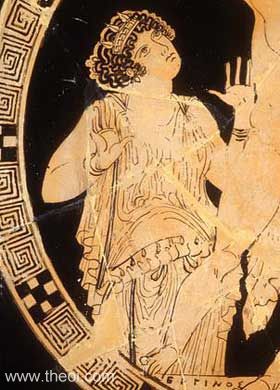
Stones: Amber (Electro), Coral
Trees & Plants: Orange, Apple Tree
KRONOS – (Saturn) 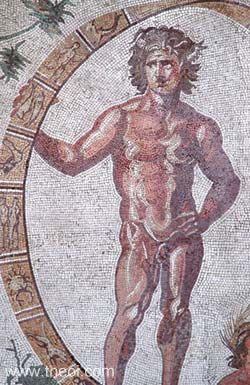
Trees & Plants: Barley, Orchid. Secondary: Corn, Lavender, Pomegranate, Raspberry.
Rea 
Trees & Plants: Myrrh
Persephone

Trees & Plants: Rodia, Poppy.
Adonis 
Trees & Plants: Myrrh, Rose, Lettuce, Fennel, heather
Asclepius 
Animals: Snake
Trees & Plants: Daphne, Mustard.
Iris
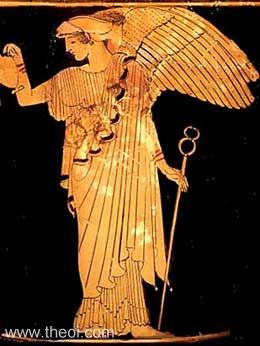
Trees & Plants: Lily
Helios – Sun Phaethon (or Aelios or “Helios”) & the chariot of the sun, Athenian
red-figure krater C5th B.C., British Museum, London 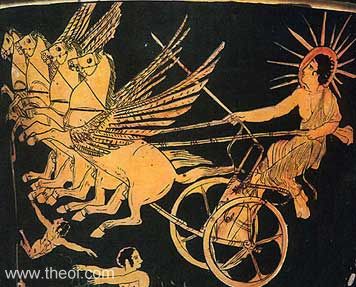
Trees & Plants: Sunflower.
Springtide
Trees & Plants: Cedar
Hypnos – Sleep
 Death and Sleep carrying the dead body of Sarpedon. Performance by erythromofro(=Red shaped) goblet early 5th century. BC, British Museum, London
Death and Sleep carrying the dead body of Sarpedon. Performance by erythromofro(=Red shaped) goblet early 5th century. BC, British Museum, London
Trees & Plants: Poppy
Macedonia comes from the word Makednos,
also Makedon or Macedon (Greek: Μάκεδνος Μακεδών Makedōn or poetic Μακηδών Makēdōn), was, according to *Hesiod’s Eoiae or Catalogue of Women on the origin of the Greeks, the son of Thyia and Zeus, brother of Thessalian Magnes and cousin of Boeotian or Epirotan Graecus. His mother Thyia was the daughter of the Greek progenitorsDeucalion and Pyrrha and sister of Hellen, who together with his three sons Dorus, Xuthus (with his sons Ion and Achaeus) and Aeolos, comprised the set of the basic 7 ancient tribes that formed the Hellenic nation. The above genealogy is also quoted by the Macedonian historian Marsyas of Pella.
Makednos or Makedon, meaning “tall” or “highlander”, was the tribal name of the ancient Macedonians.
The route of the Argeads fromArgos,Peloponnese toMacedonia
AMAC’s (Australian Macedonian Advisory Council) role is to promote the truth concerning the Macedonian issue in Australian and international fora
PHOENICIAN “ALPHABET”: AN HISTORICAL DECEPTION
Overwhelming evidence that one of the most important discoveries in the history of civilization is Greek ,a deception that usurps and distorts Greek History and Civilization. It is of utmost importance that the truth be restored not only for modern Greece, but also for thewhole of humanity.The deception that alphabetical script was discovered by the Phoenicians is a long-lived one.For the past 14 years [the Greek scholarly magazine] Davlos has published numerous articleson this problem. This prompted K. Katis to ask that we submit a relevant article for hismainstream daily so that this important issue would become known to a wider audience.
This article summarizes the strong evidence against the “Phoenician Deception,” and proves that the greatest discovery in the history of civilization is Greek. We believe it necessary to republish this article in [this issue of] Davlos exactly as it appeared in the daily.
A SCIENTIFIC MONSTROSITY.
According to linguistic theory, an “alphabet” is defined as “the sum of symbols following a specific sequence and order used to ascribe the essential utterances of a language, under thecondition that each utterance represents only one symbol and vice-versa”. Consequently, in alphabetical script (as an example, in the writings of the people of Europe, America, Australian, as well as the other parts of the world) each letter represents one essential sound.This is not true for the imperfect alphabets expressed through syllables where each symbolrepresents a syllable (with two or more voiced sounds). For example, in Greek Linear A andB, there is a symbol that represents the syllable ko (k + o), a symbol that represents the syllable po (p + o), etc. In Phoenician writing (which has only consonants and no vowels), this situation is even worse, as far as we can tell from the small amount of existing samples.
In Phoenician, each symbol is not equivalent to one specific syllable, but to a variety of syllables, and thus the reader can use his imagination when attempting to decipher the sounds. For example, there are consonants which can be read as either ba, bou, be, bi, bo, etc. Others is not an alphabet, it is a less advanced form of writingthat can be read as gou, ga, ge, go, and so on. Consequently, Phoenician script does not constitute an alphabet, and is not even an advanced form of syllabic script nearing the perfection of the equivalent Greek syllabic writings. It is truly amazing to think that, in the academic world of the past 150 years, the almost contradictory term of “Phoenician alphabet” has been established, which, in reality refers to a type of writing that has nothing to do with an alphabet. It is even more unbelievable to think that the scientific dogma that Greek came from Phoenician has been enforced. Not only the Phoenician is not an alphabet, it is a less advanced form of writing than Greek Linear A and B.
So, professor G. Babiniotis’ statement that “Phoenician writing is something like a syllabic alphabet” must be rejected and replaced with the correct characterization of Phoenician as a “purely concise syllable system of writing,” as stated by the former president of the Greek Society of Philologists, Pan. Georgountzos (see “The Alphabet: A Greek Discovery” by Pan. Georgountzos, Davlos, issue 142, October 1993, page 8242).
GREEKNESS OF THE ALPHABET
a) Archaeological Evidence The theory that the alphabet is a Phoenician discovery has been maintained through the argument, among other things, that certain symbols of Phoenician writing are similar to the letters of the alphabet. For example, the Phoenician alef is the reverse or sideways Greek “A.” This argument was a strong one until about 100 years ago, when linguists and historians still maintained that the Greeks did not know how to write before 800 B. C.! Around 1900 A.D., however, Arthur Evans excavated the Greek Minoan Crete and discovered the Greek Linear writings, whose symbols corresponded to 17 of the 24 letters of the Greek Alphabet. Given that (A), the most ancient evidence of the Greek scripts (Linear A and Linear B) that were later discovered in Pylos, Mycenae, Menidi and Thebes — but also in more northern areas up to the Danube river as well — were dated to before 1500 B.C. And (B), that the Phoenicians and their writings appear in history no earlier than 1300 BC, Evans was the first person to express doubts about the theory that the Greeks received their script from the Phoenicians. He put forward the scientific suspicion that it was probably the other way round. The doubts pertaining as to who was first — the Phoenicians or the Greeks — in discovering writing, became a certainty when French professor, Paul Fore, an internationally acclaimed specialist on Prehistoric Archaeology, published a report in Nestor (an American Archaeological Journal of the University of Indiana — 16th year, 1989, page 2288). In this report, he submits and deciphers plates with Greek Linear writing found at the cyclopean wall of Pilikates, in Ithaca, dated, through the use of modern scientific methods, back to 2700 B.C., The language of these plates was Greek, and the decoding by professor Fore resulted in the following syllabic text, expressed phonetically: A]RE-DA-TI. DA-MI-U-A-.A-TE-NA-KA-NA-RE (ija)-TE. The phonetic equivalent of this is translated, always according to the professor, as: “Ιδού τι εγώ η Αρεδάτις δίδω εις την ανασσαν, την θεάν Ρέαν: 100 αίγας, 10 πρόβατα, 3 χοίρους” [Here is what I, Aredatis, gives to the queen- goddess Rea, 100 goats, 10 sheep, 3 pigs]. (See, “Davlos” magazine, issue 107, November 1990, page 6103). Thus, Fore proved that the Greeks were writing and speaking Greek at least 1400 years before the appearance of the Phoenicians and their script in history. But, the archaeological excavations in Greece during the last 15 years have given us many more great surprises: The Greeks were writing using not only Linear A and B, but also a type of writing identical to that of the alphabet since at least 6000 B.C. In fact, at Dispilio, in the lake of Kastoria, in northern Greece, professor G. Houmouziadis discovered a plate with writing very similar to that of the alphabet, which was dated, using radioactive Carbon- 14 and visual photothermal methodology, back to 5250 B.C. (see Davlos, issue 147). Three years later, N. Samson, a curator of the Prehistoric and Classical Antiquities Department, discovered shards of vases (“ostraka”) with letters identical to the present Greek alphabet while excavating at the “Cyclop’s Cave,” on the deserted island of Yioura, near the inhabited island of Alonnissos, in the Northern Sporades island complex. These vases were dated to5,500 to 6,000 B.C. with the same methods (see “Davlos,” issue 185, May 1997). The same archaeologist, while performing excavations on the island of Milos, discovered vessels of the proto-cycladic period (mid-3rd millennium B.C.) with letters identical to the Greek letters:
“X,” “N,” “M,” “K,” “Ξ” [ksi],”Π” [p], “Ο,” & “Ε.” (See N. Samson’s interview in Davlos,issue 204, December 1998, page 12749.)
It is apparent that these archaeological discoveries have given a “comical’ character to the so-called “Phoenician Theory” on the discovery of writing. In addition, these archaeological discoveries have revolutionized chronological dating of Greek history as it is taught today, as well as the world history of civilization itself. (See also the book by Con. Koutrouvelli, “Re- establishing the Chronology of Prehistoric Times based primarily on astronomical information from Ancient Writers,” Davlos Publishing, 1999.)
b) The somewhat mathematical proof
While the house-of-cards which provided “proof”‘ of the so-called “Phoenician alphabet” was being torn down by archaeological discoveries, another overwhelming piece of evidence surfaced. This evidence was offered to us by the 20-year long discreet and timid research of the Greek Language and Writing by a great researcher, Elias Tsatsomoiros. Unfortunately E.Tsatsomoiros passed away on December 19th 1991, after having, however, completed his revolutionary work, History of the Genesis of the Greek Language-from the hunter-gatherer to the time of Zeus-the Deciphering of the Greek Alphabet. The undersigned [writer of this article] had the honor of publishing and editing this work (Davlos Publishing, 1991), but also the honor of having worked closely with the researcher for more than a decade. We had long discussions on the numerous problems arising from the research, and we had published a series of articles in Davlos magazine. This memorable researcher proved in a remarkable way that every letter of the Greek alphabet contained a consistent code meaning, which is literally introduced either exactly or metaphorically within the general meaning of the Greek word it belongs to, as a partial meaning. Consequently, every (ancient) Greek word is basically an acronym (similar to D(imosia) E (picheirisi) H(lektrismou) [=ΔΕΗ in Greek, or as U(nited) N(ations), in English], where every letter provides a significant or less significant notional element, and then, they all together provide the logical definition of the meaning expressed bythe word. The “significant difference” of each word’s meaning is usually provided by the firstletter. Obviously, there is not enough space in this article to present the code meaning of the letters of the Greek alphabet as a whole, as they are analyzed in this revolutionary volume of research in the field of human speech. As an example, I will choose only one of the 24 letters of our alphabet, “Ypsilon” = “Y” or, small case, “u” (pronounced, long-e “eepsilon,” the 20th letter of the Greek alphabet, and familiar to us as “Y” in the so-called “Latin” alphabet– which is nothing more than a variationof the Greek “Chalcidean” alphabet). Ypsilon, therefore, as its shape indicates, has the code meaning of “a cavity” οr, if reversed, of a “convexity.” This meaning is introduced into the words containing this letter, and sometimes, by extension into the meaning of liquids (which, through their natural flow end up filling the “cavity”). I will quickly mention some of the names of vessels and liquids (such as the amphiconical κ-Υ-πελλο which is dated back to 2700 B.C. and is displayed at the Heraklion Museum). One may add to the words mentioned there, many others, such as kot-Y-li, go-Y-ttos, tr-Y-blion, p-Y-xis, amphore-Y-s, b-Y-tion, l-Y-chnos, procho-Y-s, ske-Y-os, etc, all having the meaning of a curvedobject. Also, some other words such as k-Y-hsis (rounding of the stomach ofan eng-Y-os [pregnant] woman); k-Y-ma (curving on the surface of the ocean); cr-Y-pti (curving of the ground); the preposition [h-Y-po] Y-po (meaning under a certain level); h-Y-per (preposition meaning above acertain level); Y-psos =height; and all of the hundreds of words that have h-Y-po or h-Y-per as a prefix, as well as thousands of others. This discovery, which unfortunately has been officially ignored, is a continuation of the forgotten Platonic approach to the problem of language (see Plato’s Cratylus ).
This theory:
1. Completely rejects the that the Greek language came from another language (the so-called“Indo-European”!!!), since it is proven to be the only non-conventional language of the world. In other words, the only language where a relationship betweenthe “word” (as a form) and the “meaning of the word” is established.
2. Consequently, it is proven that Greek is the first and only created language of the human species which provided the basis for all “conventional” languages, as are all the other languages of the world (where there is no causative relationship between the form and the meaning). These other languages are a corrupt form of Greek.
3. This theory proves, without a doubt, that the alphabet was created by the Greeks so that the 24 or 27 code letters would aid in attributing the meanings of the Greek words (and only of these).
4. Comparatively, this theory shows that the symbols of the Phoenician writings andtheir nouns, e.g., “alef” =ox, “beth” = hut, “gimel = camel, etc., not only do not containcoded meaning, but are also associated or refer to [the] primitive animal conditions[one would expect in a culturally backward society].
THE HERODOTUS EXTRACT
All the Greek writers who mention the alphabet (they called it “grammata”) consider it a very ancient Greek invention (by Prometheus, Palamedes, Linus, etc). The theory of the Phoenician alphabet was always, and is still, based on an exception to this general rule. Thisexception is an excerpt from Herodotus, that he himself presents as his ‘personal opinion’ (“ως εμοι δοκεει” = “as it seems to me”). This opinion was formed based on the sayings of others, as he himself mentions in the previous paragraphs (“αναπυνθανομενος” = taking information from others). Let us have a look at the Herodotus’ excerpt (History, E 58): [58. As far as the Phoenicians, they, who arrived with Cadmus, including the Gefiraioi, had lived in many other places and introduced also arts (new and unknown) to the Greeks; in fact, and also (some) writing, whichhad not been known to the Greeks before that, as I think, first this writing which was used by all the Phoenicians. With the passing of time, however, the Phoenicians changed this type of writing along with their language.]
The most important thing about this excerpt is that in the critical phrase “… ama tin foni metevallon kai ton rhithmon ton grammaton,” it is disclosed that the Phoenicians-Gefiraioi that went to Viotia with Cadmus brought some form of writing with them. But, as the Phoenicians “changed their language” (they learned Greek, in other words), they also changed their writing (they started writing, therefore, with the existing ancient Greek writing that already existed in Viotia). Although this statement was made by Herodotus, the translators, subsequently, provided the translation [meaning] that the local Greek Viotes and not the Phoenician emigrants changed their language and writing and adopted the Phoenician! This generally incoherent reference to the alphabet, as it has been saved, has been obviously altered and meddled with, who knows by whom and when. Let us look at the suspicious continuation of the text, as it has arrived to us:
Around them (the Phoenicians) lived at that place during that year (year of Cadmus) Ionian Greeks, who received through contact or through teachings by the Phoenicians their writings, changing their own writing which they used little. When using this writing and since this writing had been introduced to Greece by Phoenicians, they called it Phoenician.
Ionian Greeks living around the Phoenicians received the Phoenician writing and, using a few of its letters, since they had altered them and since it was just, they called it Phoenician-to pay tribute to the people who brought it to Greece, is a striking contradiction. Consequently, one can assume that this is a forged paragraph, hypothetically explanatory, which aims to reduce the previous statement “…as they changed their language, they changed their writing,” to an unimportant statement. This is how the “Phoenician Theory” was substantiated and is maintained as an obvious forgery.
IN ADDITION
The “Phoenician Theory” was established in Europe during a time, when, as the renowned British classical scholar, S. G. Rembroke (The Legacy of Greece, Oxford University Press, 1984) wrote, “The Phoenicians were given an intermediary role “that is not based on any historical information”. A role, in other words, of the transporter of wisdom and civilization from the “chosen” people of Israel to the “uncivilized” nations, and specifically the Greeks. This, of course, could be forgiven, since this was established around the end of the Medieval Ages, when religious fanaticism and backwardness had reached such a point that the daughter of Agamemnon, Iphigenia, is presented as the daughter of Iephtha; Deukalion is presented as…”Noah”(!!); Appis is a consul of Joseph; Apollo, Priam, Tiresias, and Orpheus are corrupted alias HYBRIDES personae of Moses. The story of the Argonauts is the crossing of the Israelites from Egypt to Palestine, and other similar distortions. The above are noted by Rembroke.
And we conclude: At the time, Hellenism was in comatose spiritual condition regarding national and historical awareness, and therefore totally unable to defend its history and civilization, and for this reason could not react and did not react. Today, it is with ourtolerance that our language is deemed “Indo-European,” and our writing “Phoenician,” our Athena and our Socrates are presented as “Blacks,” and our civilization as “African.” What spiritual situation are we in now? [i.e., What’s our excuse this time?]
Notes: On page 13745 of this article, is a picture of a piece of shard [pottery] dated to 6,000 B.C., found on the islet of Youra of the North Sporades island complex with Greek alphabetical writings. One can see the letters “A,” “Y,” & “D” [alpha, eepsilon, and delta ], almost identical to the Greek letters of the classical alphabets. This finding proves that the Greek alphabet is older than the Greek Linear writings. This finding also completely and definitely disproves the false theory that the Greeks got their alphabet from the Phoenicians, who made their historical appearance around 1300 B.C., in other words about 4,500 to 5,000 years after the creation of this plaque at Youra. On page 13747 are shown letter-symbols from the Proto-cycladic vessels of Milos (mid-third millennium B.C.). One can distinguish the [letter] “X” [chi] to the left and the [letter] “N” to the right. These letters are written just as the letters of the Greek alphabet are written today.
NO matter how different Mishellenic(=Greek hating) & Anthhellenic(Antigreek) Evil & Dark powers, who lead the media towards to blind & uneducatated main stream, who, is the BIGEST victim of all! (“History Chanel, Politicians..etc…the: NEW(!!!) Historical Identity for “Macedonians”, who spealk Wardaskian slavic, Turkish, as ….ancient Trojans(!!!!!!)..but the Temples, the religion, the Etymology, the Philosphy, the Poetry, the Astronomy, the Drama & Theater , the mathematics, names, the REAL Histrorical facts, the LOGICAL CONTINUATION (& Conection of the Language to the: mathematical, architectical, poetical, rythmical, orthological inTime & FACTS is more than ENOUGH to reveal who`s who in the..ZOOO & for NOT understanding characters with NO so much of I.Q, is just very tragic!
Other vessels were also found with “M,” “K,” “Ξ” [ksi], “Π” [p], “O,” and “E.” Source.
Nicander of Colophon
Nikander, Theriaca, 10th century, Constantinople
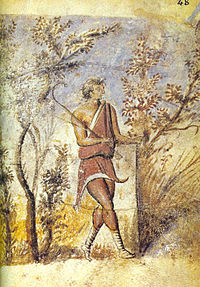 (Greek: Νίκανδρος ὁ Κολοφώνιος Níkandros ho Kolophṓnios; fl. 2nd century BC), Greek poet, physician and grammarian, was born at Claros (Ahmetbeyli in modern Turkey), near Colophon, where his family held the hereditary priesthood of Apollo. He flourished under Attalus III of Pergamum.
(Greek: Νίκανδρος ὁ Κολοφώνιος Níkandros ho Kolophṓnios; fl. 2nd century BC), Greek poet, physician and grammarian, was born at Claros (Ahmetbeyli in modern Turkey), near Colophon, where his family held the hereditary priesthood of Apollo. He flourished under Attalus III of Pergamum.
He wrote a number of works both in prose and verse, of which two survive complete. The longest, Theriaca, is a hexameter poem (958 lines) on the nature of venomous animals and the wounds which they inflict. The other, Alexipharmaca, consists of 630 hexameters treating of poisons and their antidotes. Nicander’s main source for medical information was the physician Apollodorus. Among his lost works, Heteroeumena was a mythological epic, used by Ovid in the Metamorphoses and epitomized by Antoninus Liberalis; Georgica, of which considerable fragments survive, was perhaps imitated by Virgil.[1]
The works of Nicander were praised by Cicero (De oratore, i. 16), imitated by Ovid and Lucan, and frequently quoted by Pliny and other writers (e. g. Tertullian in De Scorpiace, I, 1).


